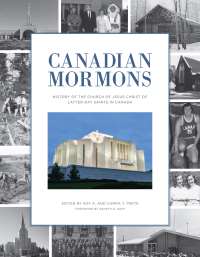Saskatchewan
Kenneth A. Svenson
Kenneth A. Svenson, “Saskatchewan,” in Canadian Mormons: History of the Church of Jesus Christ of Latter-Day Saints in Canada, ed. Roy A. and Carma T. Prete (Provo, UT: Religious Studies Center; Salt Lake City: Deseret Book, 2017), 306-327.
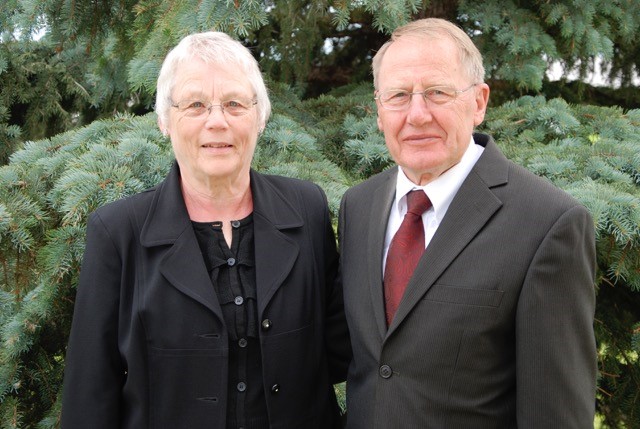
A native of southern Alberta, Kenneth A. Svenson obtained a BA in sociology from the University of Alberta and later took several graduate courses. He was employed by the governments of Alberta and Saskatchewan at the policy level with regard to employment, economic development, and social policy. He was owner and principal partner in Svenson and Associates Consultants and was a partner in Associated Counseling Network for twenty-eight years. He is the principal editor and compiler of The Hand of the Lord: A History of The Church of Jesus Christ of Latter-day Saints in Saskatchewan (2014). A former stake president, he was coordinator of the Regina Temple open house and dedication committee prior to the temple dedication in 1999. He is married to Grace Mendenhall, and they are the parents of five children and have twenty grandchildren. (Kenneth Svenson)
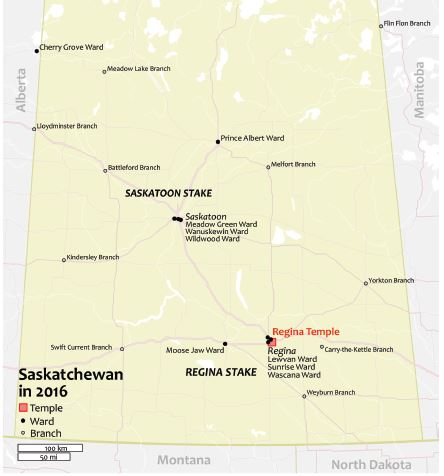 The Church in Saskatchewan started in the early 1900s with scattered families coming from the United States to homestead, and the province was one of the last to receive missionaries in 1925. Despite numerous challenges, the Church has since grown, and in 2015, it had two stakes and a temple, with a total provincial membership of over five thousand.
The Church in Saskatchewan started in the early 1900s with scattered families coming from the United States to homestead, and the province was one of the last to receive missionaries in 1925. Despite numerous challenges, the Church has since grown, and in 2015, it had two stakes and a temple, with a total provincial membership of over five thousand.
The history of the Church in Saskatchewan differs notably from that in Alberta, Saskatchewan’s neighbour to the west.[1] Alberta Church history began with significant migrations from the major centres of the Church in Utah and Idaho, creating communities in southern Alberta in which members of the Church were predominant, which provided both religious and secular leadership. Many descendants of these early Alberta pioneers migrated to cities, acquired higher education and technical expertise, and became the foundation for the growth of the Church in the major cities of Alberta and contributed significantly to the Church’s development in many other areas of Canada, including Saskatchewan.
The growth of the Church in Saskatchewan has been much more incremental and gradual. It began with the migration of isolated individuals and families in the early twentieth century, and growth has largely depended on missionary work and the dedication and faithful service of the members over a period of many years. On 3 August 1998, President Gordon B. Hinckley announced that a temple was to be built in Regina, Saskatchewan; it was dedicated just over a year later. This chapter is the story of how the Lord’s hand has been manifest as the Church in Saskatchewan has progressed from a handful of Church members in the early 1900s to over five thousand members in 2015, with a temple and two stakes to bless the lives of faithful Saints in the province.
The Saskatchewan Economy
Many forces have shaped the growth of The Church of Jesus Christ of Latter-day Saints in Saskatchewan, not the least of which has been the economy. When the American settlement frontier closed at the end of the nineteenth century, the Canadian government conducted a large-scale advertising campaign in Europe and the United States, encouraging settlement in western Canada as “The Last, Best West.” Settlers could register for a 160-acre tract of land, pay a ten-dollar homestead registration fee, and if they brought a specified amount of land under cultivation within three years, they could receive title to the land.[2] In the wave of migration that followed, several early members of the Church came to Saskatchewan as homesteaders in quest of free land.
Saskatchewan is largely an agricultural province, and much of the agricultural production (primarily grains and, more recently, oilseeds) is exported. Other economic engines are potash and uranium mining, forestry products, and oil and gas, and all are generally dependent upon export markets. When prices are high, the province grows in population, but when the economy slows, Saskatchewan exports people! The province’s population, with its ups and downs, has hovered around one million since the early 1930s, the period during which the Church was being established.[3] Thus, in addition to a harsh climate and vast distances, the province’s fluctuating economy has posed serious challenges to the development of the Church.
The migration of isolated members of the Church to Saskatchewan began early in the twentieth century. The first known Church member to come to the province was Jenett Williams Lynds, who immigrated to Saskatchewan with her husband, Abner, in 1903, homesteading in the Briercrest area southwest of Regina. Jenett had been baptized in Salt Lake City, Utah, in 1891.[4] Flora Isabel Englesby, who joined the Church in 1903 in Mondova, Wisconsin, arrived in the Melfort area in 1905, the year Saskatchewan became a province. She and her husband, Harrison, homesteaded at Morwick, south of Melfort.[5]
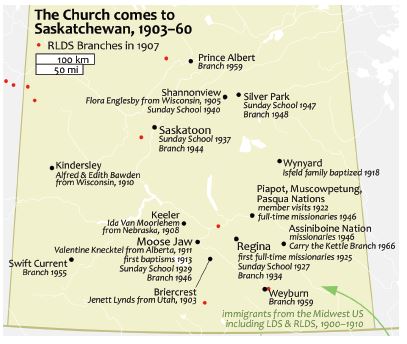
Other Church members arrived in the following years. Ida Amalia Peterson Van Moorlehem, who had been baptized in 1898, immigrated to Canada from Nebraska with her husband, Isadore, in 1908, homesteading in the Keeler area, northwest of Moose Jaw.[6] Alfred and Edith Bawden and their daughter, Ethel Annie, all who had been baptized previously, emigrated from Wisconsin to Saskatchewan in 1910 to homestead in the Kindersley area.[7]
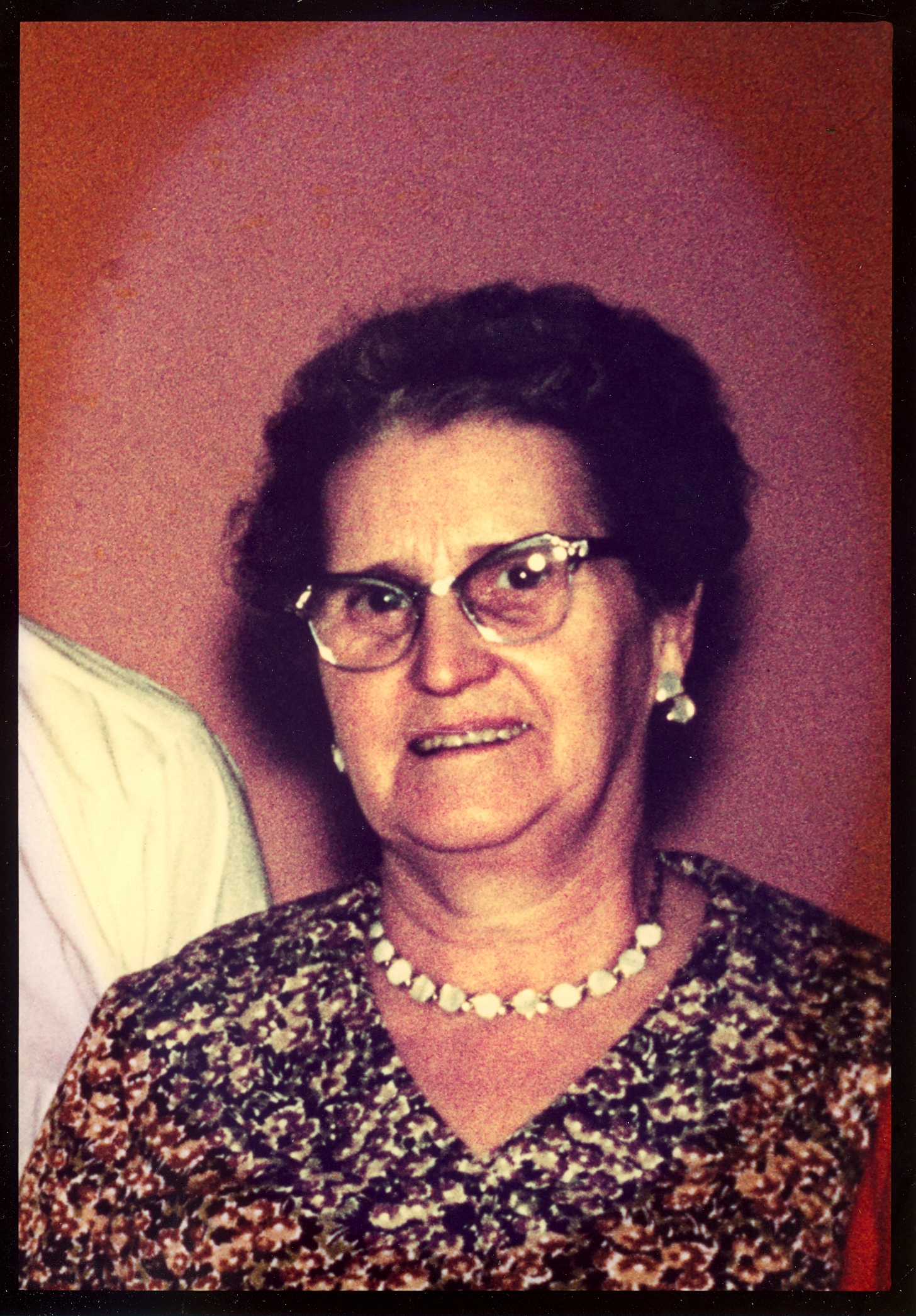 Ethel Annie Bawden moved with her parents to Kindersley in 1910, having joined the Church with her family in Wisconsin. By the time missionaries visited her in 1940, thirty years later, her parents and her husband, Samuel Swalm, had died. In 1950, her daughter Fay was baptized, followed eight years later by Fay’s husband, Keith Campbell. Keith served as presiding elder or branch president in the Kindersley branch for a total of twenty-one years. (Earl Campbell)
Ethel Annie Bawden moved with her parents to Kindersley in 1910, having joined the Church with her family in Wisconsin. By the time missionaries visited her in 1940, thirty years later, her parents and her husband, Samuel Swalm, had died. In 1950, her daughter Fay was baptized, followed eight years later by Fay’s husband, Keith Campbell. Keith served as presiding elder or branch president in the Kindersley branch for a total of twenty-one years. (Earl Campbell)
First Converts
Born in Ontario, Valentine Knecktel was baptized in Alberta in October 1911, although he was at that time living in Moose Jaw.[8] Knecktel soon proved to be an outstanding missionary. In 1912, he introduced the gospel to George Gordon Whyte, who would play a prominent role in the growth of the Church in Saskatchewan for the rest of his life. Whyte recorded his conversion in his journal:
In the fall of 1912 Mr. Knecktel handed me a Book of Mormon to read. [He] said it was a record of the Nephites, the ancestors of the Indians we see on the Reserves. I read it through twice, and the more I read the more I was convinced it was a divine record of the dealings of the Lord with those ”other sheep” he spoke of when in Jerusalem. . . . In spite of . . . opposition on the part of my friends and relatives I kept on reading, and on the 17 August 1913, I was baptized in the Moose Jaw Creek, three miles south of town, by Bro V. Knecktel, who had previously . . . been ordained an Elder. Jack Mackenzie was baptized at the same time.[9]
Whyte was unemployed at the time of his baptism, but the day after his baptism he obtained a good job with the Saskatchewan Cooperative Elevator Company, which gave him a secure income for the rest of his career.[10]
Five years later, the Magnus and Elin Isfeld family of Foam Lake (near Wynyard) became the first convert family in the province. The unusual story of their conversion is related in the sidebar.
Member Missionary Work
Although missionaries were not assigned to Saskatchewan prior to 1925, member missionary work among people in the province went forward. Whyte and Knecktel shared the gospel with those willing to listen, and several joined the Church. In the summer of 1919, Valentine Knecktel baptized Ada Alice King in Moose Jaw and Edward Silverson in Briercrest.[12] G. Gordon Whyte baptized Mervyn Snow in July 1919. Auder Emelie Isfeld (daughter-in-law of Magnus Isfeld) of Edenwold was baptized in May 1924, and Carl Jacob and Matilda Alicia Rollefson of the Kindersley area were baptized in August of the same year.[13]
Due to their widely scattered locations, each of these early members of the Church had to maintain their testimonies of the gospel and their personal worthiness without the support of local Church organization for many years. Whyte and Knecktel tried to keep in contact with Church members and to locate other members of the Church whenever they could, including isolated families and individuals who had moved to Saskatchewan for various reasons. For example, in October 1924, Whyte received a letter from Ida Van Moorlehem of Keeler, who had been living there for sixteen years with no Church contact. Two weeks later, Whyte took the train to Moose Jaw and drove with Knecktel to Keeler, where they met and held a service with Van Moorlehem and her family.[14] In November 1925, Whyte and Knecktel visited the Rollefsens in Moose Jaw, the Van Moorlehem family in Keeler, and the Jenett and Abner Lynds family and Edward Silverson in Briercrest.[15] This type of service was typical of the diligent shepherding performed by Whyte and Knecktel over the many years before the Church was formally organized in Saskatchewan. Membership records for some of the early members of the Church in Saskatchewan appear in the records of the Raymond First and Raymond Second Wards in Alberta.[16] However, the membership records of the Isfeld family were held in the Manitoba District until 1925.[17]
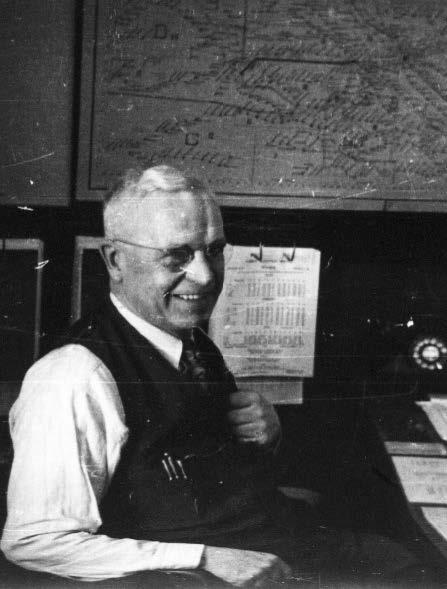 One of the first baptized members in Saskatchewan in 1913, George Gordon Whyte served in important leadership roles during the early period of the Church, shepherding scattered Church members and working with First Nations people before missionaries arrived in 1925. He was the first branch president in Regina, 1934–46, the first local member president of the Saskatchewan District in 1945, and later served as a counsellor in the mission presidency. Whyte’s extensive journals are a major source for the early history of the Church in Saskatchewan. (Sylvia De Leyssac)
One of the first baptized members in Saskatchewan in 1913, George Gordon Whyte served in important leadership roles during the early period of the Church, shepherding scattered Church members and working with First Nations people before missionaries arrived in 1925. He was the first branch president in Regina, 1934–46, the first local member president of the Saskatchewan District in 1945, and later served as a counsellor in the mission presidency. Whyte’s extensive journals are a major source for the early history of the Church in Saskatchewan. (Sylvia De Leyssac)
Work with First Nations
During those early years, Whyte was involved in missionary work among the native people of southern Saskatchewan. On a Sunday in August 1922, he felt impressed to visit with a group of ten to twelve native families who were camped at the fairgrounds: “I . . . found a young intelligent man by the name of John Gambler,” Whyte recorded in his journal. “I told him, I had a book that was a history of their people for a thousand years and how God our Father had dealt with their forefathers. He seemed interested and asked me to come out to the reserve and see him.”[18] On 29 October 1922, Whyte further recorded in his journal: “Today, I was impressed to drive out and see them [on the Muscowpetung Reserve] again and the joy that I have experienced is beyond expression. My coming was known before I arrived for John Gambler kept telling his wife the day before . . . that he was sure I was coming and they were not disappointed when I showed up about 3 p.m.”[19]
Whyte reported that great interest was shown by First Nations people because of their having heard the teachings of Tom Patchapace of the Moose Mountain Reserve. Patchapace, as a result of a series of visions, preached that God had a physical body and that a book would be brought to them by a white man that would tell of their ancestors.[20]
Whyte did not see the conversions among the First Nations peoples that he might have expected, in part due to government regulations,[21] but he made other progress important to the Church’s mission when he began to record the genealogical information of their ancestors. On 25 November 1927, he wrote that he had recorded eighty names for ordinance work in the Cardston Alberta Temple.[22] Whyte’s diligent missionary, genealogical, and temple work efforts with the Native Canadian population continued throughout his life.
Missionaries Assigned
The first missionaries to be located in Saskatchewan full time were assigned from the North Central States Mission in 1925. On 10–11 July 1925, John G. Allred, president of the North Central States Mission, and G. Gordon Whyte, the only Church member living in Regina, held the first recorded street meetings in Regina. In his opening statement, Whyte declared, “We are here to preach the gospel of the Lord Jesus Christ, and the dispensation of the fullness of times is now opened up in Regina for the first time.”[23] The first missionaries, Raymond L. Allen and Reuben T. Reynolds, arrived in Regina on 23 July and, within a day of their arrival, held their first street meeting. By the end of August, the elders in the Regina area had placed fifty copies of the Book of Mormon.[24] Leo E. Nielsen and John Alma Ward were assigned to Saskatoon in July 1925, where officials generally cooperated in granting permission for street meetings.[25]
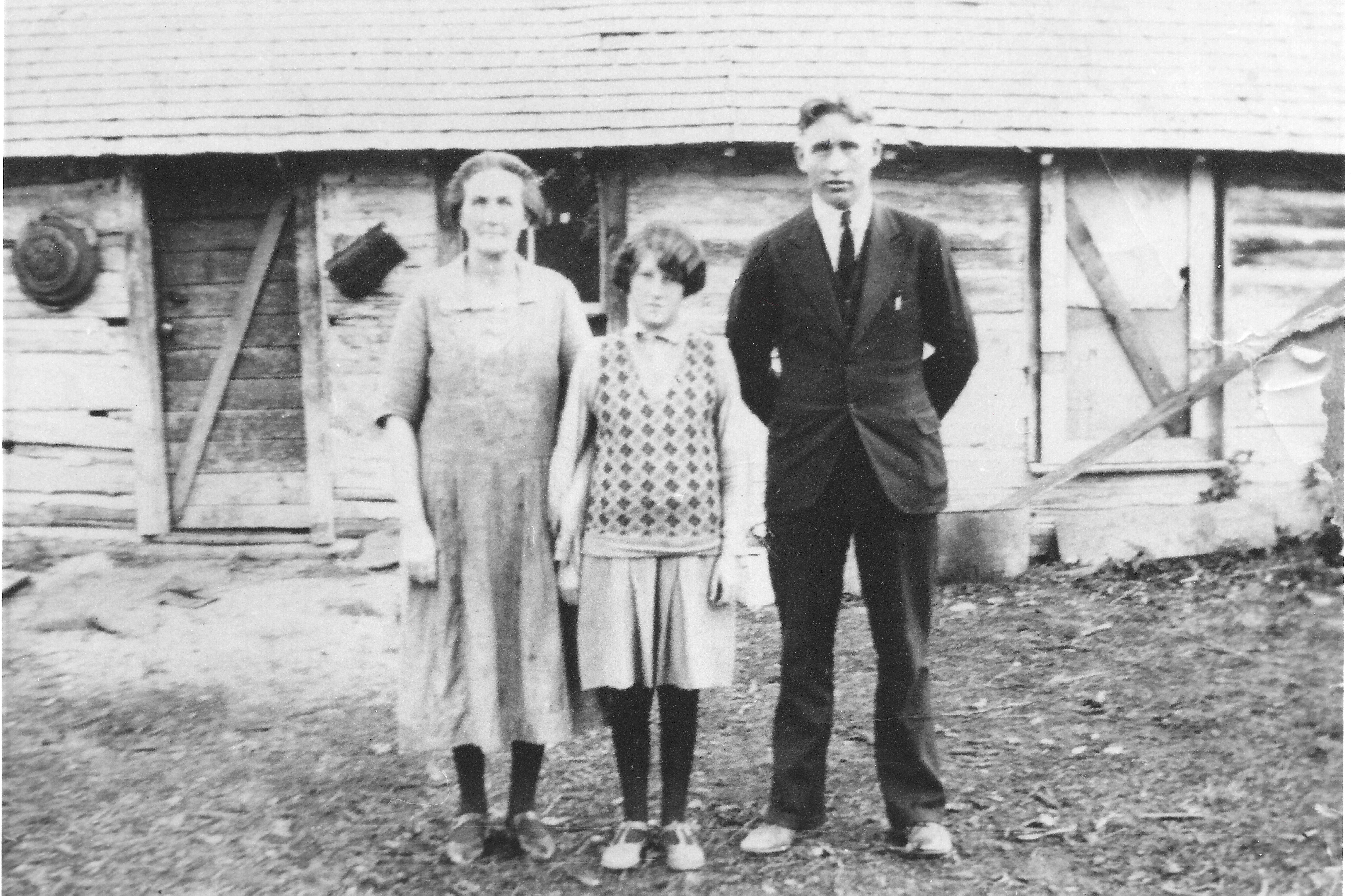 Flora Englesby, left, with her daughter Florabell and a missionary, Nephi Berg, in front of the Englesby pioneer home in 1928. Englesby was one of the first Church members in Saskatchewan, and her request for missionaries in 1926 ultimately resulted in many baptisms in the Shannon View and Silver Park areas. (Marlene Breti)
Flora Englesby, left, with her daughter Florabell and a missionary, Nephi Berg, in front of the Englesby pioneer home in 1928. Englesby was one of the first Church members in Saskatchewan, and her request for missionaries in 1926 ultimately resulted in many baptisms in the Shannon View and Silver Park areas. (Marlene Breti)
When Flora Englesby, who was living in Morwick and who had had no contact with other Church members for seventeen years, read in the Western Producer that Latter-day Saint missionaries were labouring in Regina, she was overjoyed. She wrote a letter in 1926 requesting that missionaries be sent to visit her. Over the years, many people were baptized as a result of missionaries being sent to the area.[26]
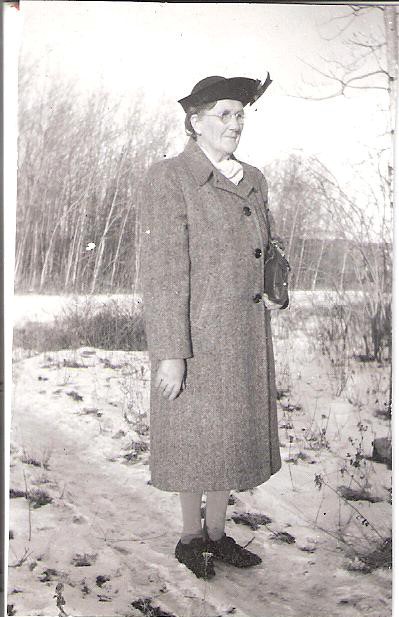 This photograph of Flora Englesby was published in a 1947 Church News article that highlighted her missionary efforts. (Keith Willoughby)
This photograph of Flora Englesby was published in a 1947 Church News article that highlighted her missionary efforts. (Keith Willoughby)
Over a period of many years, before local organizations of the Church were established, missionaries made sporadic visits to the scattered members in the province, sometimes travelling as much as 1,200–1,500 miles.[27] On these visits, cherished by the members, the missionaries taught the gospel to scattered members, including the Englesbys and their neighbours, blessed and baptized children, and provided support.[28]
Visits of General Authorities
The first General Authority of the Church to visit Saskatchewan was Joseph Fielding Smith of the Quorum of the Twelve Apostles, who visited Saskatoon on 18 March 1926 and Regina the next day.[29] This was a momentous occasion in the mind of G. Gordon Whyte, who wrote in his journal on 19 March 1926:
This is a day of days I have looked forward to, when one of the apostles would come here to visit us. As I wished to enjoy his company along with Brother [John G.] Allred [president of the North Central States Mission], I did not go to the office all day. In the evening we had a fine meeting with about 60 people present. Apostle Smith spoke on doctrine. The whole day was a spiritual feast and my heart responded to it all. This city was greatly blessed in having an apostle of the Lord here but they did not know it.[30]
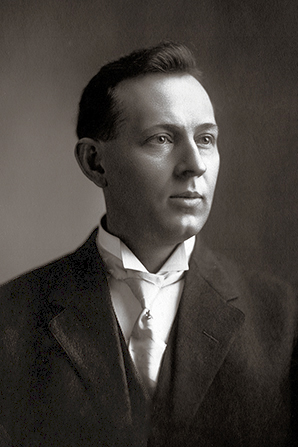 Joseph Fielding Smith of the Quorum of the Twelve, later President of the Church, visited Saskatchewan and Manitoba in 1926 as part of a tour of the North Central States Mission. (IRI)
Joseph Fielding Smith of the Quorum of the Twelve, later President of the Church, visited Saskatchewan and Manitoba in 1926 as part of a tour of the North Central States Mission. (IRI)
The next year, on 14 June 1928, David O. McKay of the Quorum of the Twelve, accompanied by John G. Allred, the mission president, visited Regina, where McKay, later President of the Church, thrilled a gathering of eighty-three Saints assembled from Regina and surrounding areas.[31]
Increase in Baptisms
In mid-1927, as baptisms increased, baptismal services needed to be held weekly or biweekly for three months. Wascana Creek, west on thirteenth Avenue in Regina, along the Canadian National Railway line, was the location of a baptismal service on 5 June 1927.[32] The events surrounding one of these early services were particularly faith promoting. On 19 June 1927, Whyte recorded the following:
In [the] afternoon about 2 p.m. a terrific rain and hail storm started. We had planned on a baptismal service at 3 p.m. By 2:30 p.m. it was flooding everything and, feeling impressed that the Devil had a hand in the storm to try to dampen our plans to hold a baptism at the river, I went upstairs and prayed the Lord would overrule and that at 3 p.m. it would clear up and the sun would shine. Promptly at 3 p.m. the storm stopped, . . . the sun came out and I made preparation for the service. On reaching the place, I learned that the four elders [had] been praying for the same thing. Four souls were added to the fold. About 25 were present at the service.[33]
First Sunday Schools
Held in the home of Mervyn Snow, the first Sunday School in Saskatchewan was organized in Regina on 8 May 1927, with twenty-one people present. G. Gordon Whyte was appointed superintendent, with Mervyn Snow and Eric Fielding as assistants, and Rose Snow (not yet a member) as secretary.[34] A year later, the Regina Sunday School was holding joint services, at least periodically, with the Church members in Moose Jaw.[35]
By the following year (1929), Sunday School was being held regularly in Moose Jaw, at the homes of either W. R. Bennett (formerly of Calgary) or John W. and Lucile McCaslin, with missionaries presiding.[36] In 1930, the first Relief Society was organized in Regina, with Isobel Lamb as president and with Lilly S. Dixon and Emily P. Miller as counselors.[37]
North Saskatchewan District
Meanwhile, the Church was beginning to be established in the northern part of the province. In September 1925, only weeks after the first “permanent” missionaries arrived in Saskatchewan, the province was organized into two districts—the North Saskatchewan District, based in Saskatoon, and the South Saskatchewan District, based in Regina.[38] Although the North Saskatchewan District was effectively closed in 1927, missionaries from Regina made periodic visits to the north, and growth continued in the northern part of the province. In 1927, missionaries baptized Flora Englesby’s husband, Harrison, and two of their daughters, Mae Englesby Prete and Florabell Englesby, in the Shannon View area south of Melfort.[39]
By 1930, total Church membership across Saskatchewan had reached 145.[40] This number included pockets of Church members in the north—the Englesby and Prete families in the Melfort area, the Isfeld families in the Wynyard area, and the McLeod and Meeter families in Saskatoon. These small groups of Saints had survived and grown, supported by intermittent visits from missionaries in Regina.[41]
First Branch
A major step toward the development of the Church in Saskatchewan was the organization of the Regina Branch on 27 May 1934. G. Gordon Whyte was appointed branch president. Eighteen people attended the organizational meeting—eleven Church members and seven investigators.[42] Branch membership at the time was about forty people.[43]
The appointment of Victor Waddoups, a missionary, as president of the Saskatchewan District in September 1938 brought progress to the Church in Saskatchewan. Waddoups encouraged missionaries to establish Sunday Schools and Relief Societies wherever there were a few converts, and to develop local leadership as a foundation for eventual establishment of branches.[44]
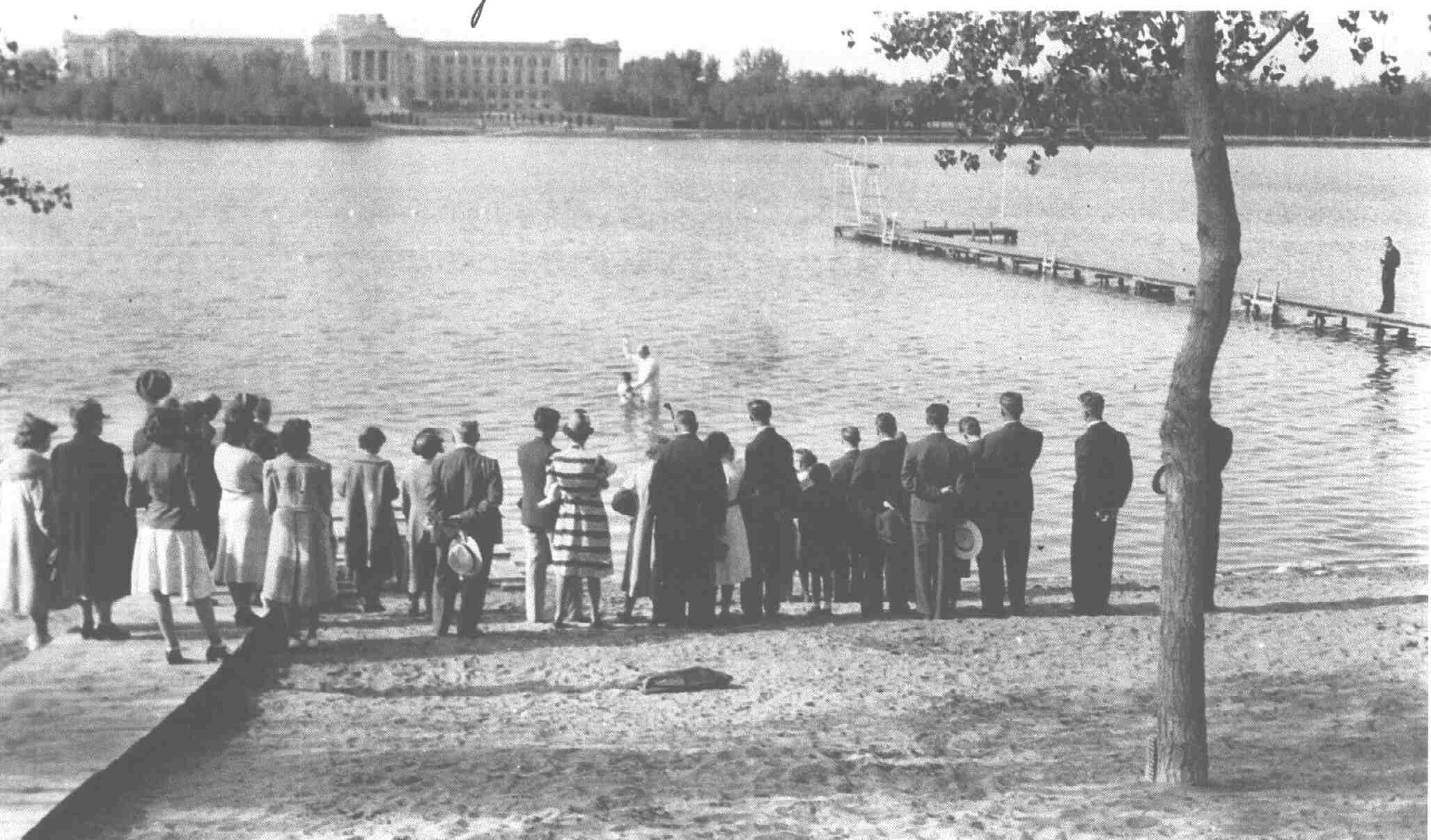 The largest known baptismal service in Saskatchewan was held in May 1939, when fifteen people were baptized at Wascana Lake in Regina. The Saskatchewan legislative building can be seen in the background. (Dorothy Muirhead)
The largest known baptismal service in Saskatchewan was held in May 1939, when fifteen people were baptized at Wascana Lake in Regina. The Saskatchewan legislative building can be seen in the background. (Dorothy Muirhead)
On 28 May 1939, an impressive baptismal service was held in Regina. G. Gordon Whyte, president of the Regina Branch, recorded that Victor Waddoups performed fifteen baptisms that day, a number which represented a 34.8 percent increase in the membership of the Regina Branch.[45] It was likely the largest number of people baptized in a single service in the history of Saskatchewan. This rapid increase in branch membership created the foundation for the future growth of the Church in Regina. One of the people baptized that day was Burnard Dawe, who succeeded G. Gordon Whyte as branch president in Regina in 1946; another was Thomas Kemp, who became the first president of the Weyburn Branch in 1959.[46]
Meetinghouse in Regina
In 1936, G. Gordon Whyte wrote to the mission president articulating the desire of local Church members to have their own meetinghouse. Whyte pointed out that meeting in rented facilities was unsatisfactory because of the tobacco smoke and that an LDS building would increase the visibility and prestige of the Church. A year earlier he had reported that “in the last two or three years forty five Saints have moved away from here to the west,” leaving the branch with just thirty-six members, and making “it difficult to build a permanent place of gathering for the Saints.” Had the branch had an LDS meetinghouse earlier, Whyte urged, it might have retained some of the members who had moved to the west.[47]
The year 1940 brought a momentous event for the Saints in Regina: the purchase of a meetinghouse at 1409 Victoria Avenue (the corner of Victoria and Ottawa streets). The decision to buy the building at a purchase price of $3,509 was made on 14 April. The structure required some major renovations, including the installation of a new hardwood floor and changes to accommodate LDS-style meetings. The entire branch participated in the renovations through contributed labour and other donations. Fifty-four people attended the first services held in the newly renovated meetinghouse on 19 May 1940—a priesthood meeting followed by Sunday School. The meetinghouse was dedicated on 23 June 1940.[48]
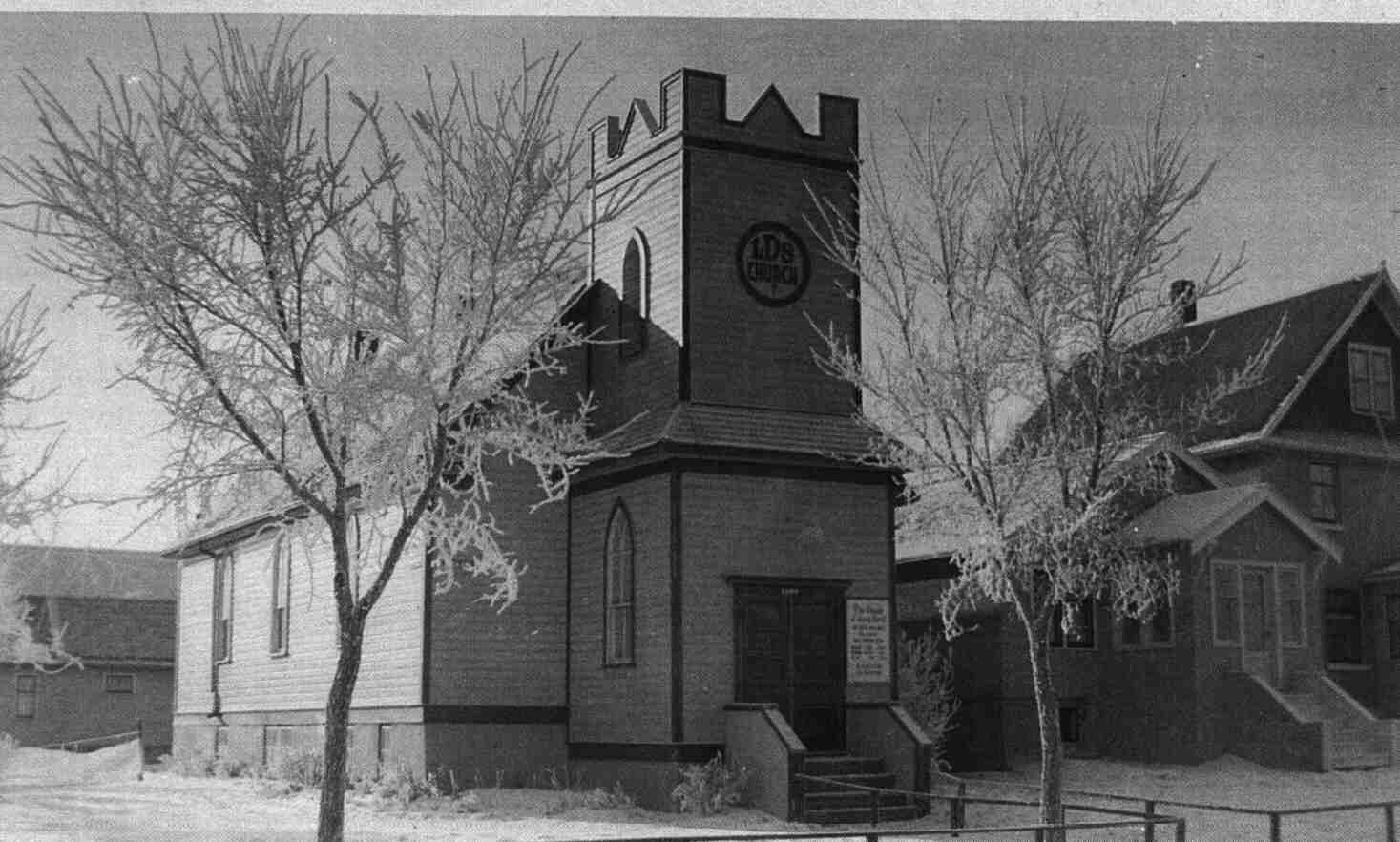 The first Church-owned meetinghouse in Saskatchewan was located at 1409 Victoria Avenue in Regina. It was purchased in 1940 from a Lutheran congregation and was dedicated by Richard R. Lyman of the Quorum of the Twelve Apostles. This building served the Regina Saints until 1958, when an LDS meetinghouse was constructed on Broadway Avenue. (Dorothy Muirhead)
The first Church-owned meetinghouse in Saskatchewan was located at 1409 Victoria Avenue in Regina. It was purchased in 1940 from a Lutheran congregation and was dedicated by Richard R. Lyman of the Quorum of the Twelve Apostles. This building served the Regina Saints until 1958, when an LDS meetinghouse was constructed on Broadway Avenue. (Dorothy Muirhead)
Challenges of the Great Depression
The Great Depression caused considerable hardship throughout the world, but in Saskatchewan, the effects were particularly severe. Not only were worldwide commodity prices extremely low, but a concurrent nine-year drought turned the fertile prairies of Saskatchewan into a dust bowl. Conditions grew increasingly more desperate, especially for rural residents. It was estimated that by 1937, more than two-thirds of Saskatchewan’s farm families were destitute. The Canadian government sent relief in the form of railway cars loaded with food and clothing[49] to Saskatchewan from other areas across Canada that were not so hardly hit by the drought.
In a magnanimous act in 1934, the Lethbridge Stake in Alberta, where irrigation had mitigated the effect of the drought, participated in this relief effort, with Church members filling a boxcar full of produce and other supplies for needy people in Saskatchewan; the nonmember population of Lethbridge and area joined the effort by filling a second boxcar. The first boxcar arrived in Regina just before Christmas, the second shortly after. Arrangements were made with the Canadian Pacific Railway to transport the shipment free of charge. The United Church of Canada assisted in distributing the food to needy families in Saskatchewan, including some members of the Regina Branch.[50]
In April 1937, in response to prevailing conditions, G. Gordon Whyte encouraged members of the Regina Branch to store food, clothing, and other necessities. This continued after 1939 during the war years. In 1943, the branch had more than six thousand pounds of flour stored in the basement of their meetinghouse. In 1945, the branch used a pressure canner to add to their collective food storage.[51]
During the Great Depression, the population of the province declined as people sought better economic opportunities elsewhere. Move-outs likewise proved to be an ongoing challenge to the growth of the Regina Branch during the Depression years, sapping much of the local increase. In July 1939, Victor Waddoups noted that there were only fifty-five Church members in the branch, although there had been two hundred people baptized there. Many of the converts, he observed, had moved from Saskatchewan to find better economic conditions and to live in organized stakes of the Church.[52]
Expansion of the Work, 1934– 78
Following the creation of the Regina Branch in 1934, more branches were organized as the number of Saints grew in various locations, and, in due course, meetinghouses replaced rental halls as places of worship.
In Saskatoon, the first Sunday School was held on 31 October 1937 in the home of Arlo and Zina Palmer, under the direction of Leonard J. Shields.[53] The Saskatoon Branch was organized on 29 February 1944 with Sidney B. Smith (a senior missionary) as president, and with forty-one people in attendance.[54] The branch met in the IOOF Hall (Independent Order of Odd Fellows) on Twenty-First Street, and in later years in the Mayfair Hall on Thirty-Third Street.[55]
A conference was held in Moose Jaw in May 1946, with twenty-nine people present.[56] The Moose Jaw Branch was officially created in December 1946.[57]
Resulting from the missionary efforts of Flora I. Englesby and the occasional visits of missionaries, small groups of converts were made in the Shannon View and Silver Park areas during the 1930s and 1940s. Sunday School began in 1940 in Shannon View (Preeteville) and in 1947 in Silver Park.[58] The first LDS conference, which combined both groups, was held at Shannon View School on 25 May 1946, with an attendance of fifty-three, including Joseph Y. Card, president of the Western Canadian Mission.[59]
In 1947, the North Saskatchewan District, covering the northern part of the province, including the Shannon View and Silver Park areas, was reestablished under missionary leadership. G. Gordon Whyte, who had been appointed president of the Saskatchewan District in 1945, continued as president of the reconstituted South Saskatchewan District.[63]
On 19 September 1948, the Silver Park Branch was organized with Victor E. Clark as branch president. Membership was twenty persons.[64] In the 1950s, as a number of Saints in Shannon View moved away, the remaining Church members in Shannon View began attending the Silver Park Branch, which in 1963 became the Melfort Branch.[65]
Missionary work in rural Saskatchewan in the late 1940s posed some interesting challenges with regard to lodging and transportation. For example, missionaries Calvin Fife and Richard J. Halterman arrived in the Shannon View (Preeteville) area on 12 June 1947, where they initially stayed at the Frank and Lydia Preete home. Fife and Floyd W. Clegg, who replaced Halterman after a month, fixed up a chicken coop to live in. For transportation, the two missionaries purchased a horse from Frank Preete and a harness from John Prete, and found an old cart, which they repaired.
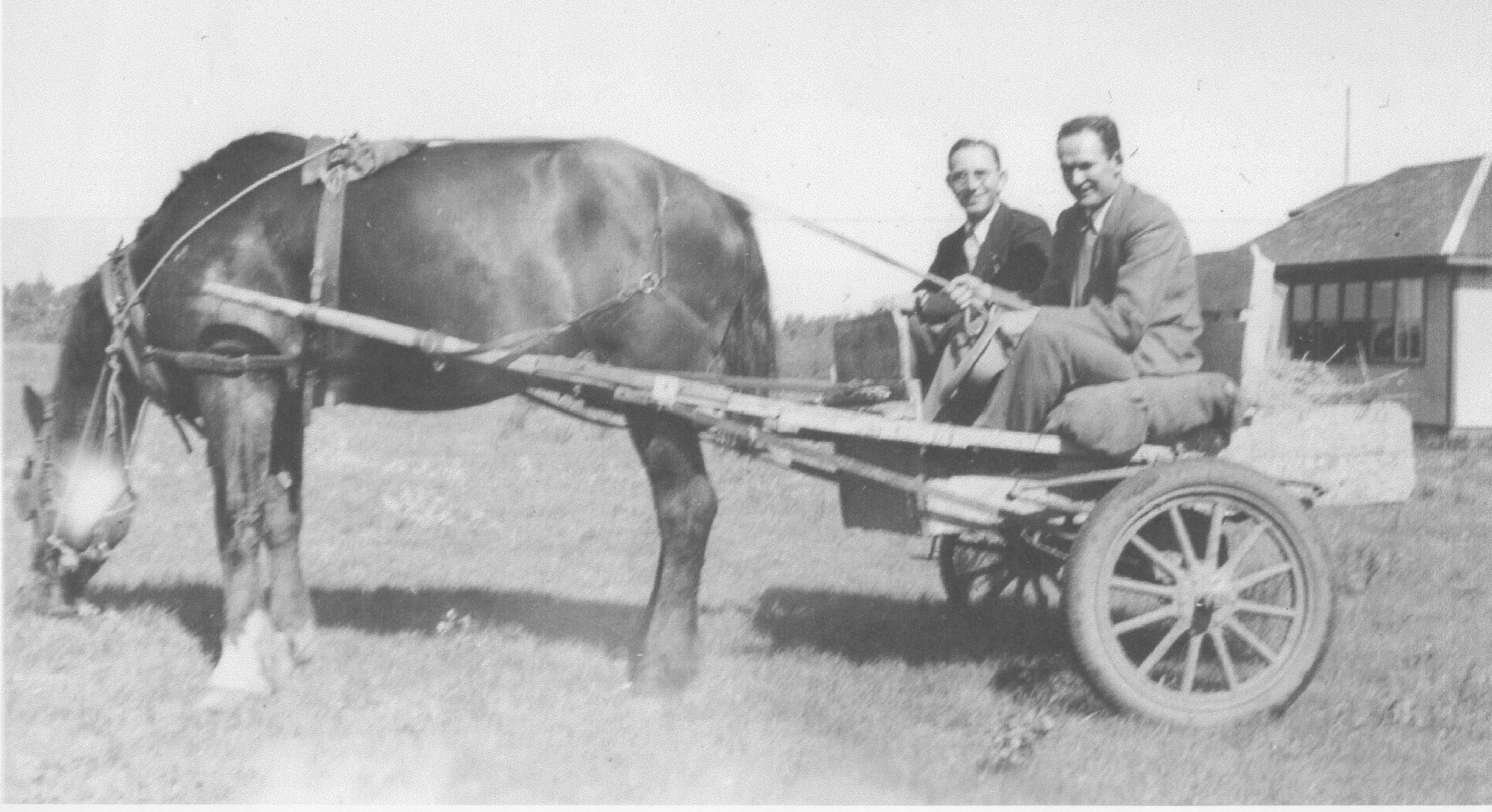 Missionaries Calvin Fife (left) and Floyd W. Clegg. For the winter travel, they used a tiny horse-drawn “caboose” on runners, with a small stove inside. (Valeta Fife)
Missionaries Calvin Fife (left) and Floyd W. Clegg. For the winter travel, they used a tiny horse-drawn “caboose” on runners, with a small stove inside. (Valeta Fife)
By June 1948, missionaries, with the help of local Church members and friends, had constructed a new dwelling, a log cabin on the Frank Preete property. Although missionaries were transferred from the area soon thereafter, Church members used the cabin as a meetinghouse for several years.[66] Missionaries working in the Silver Park area and the Carry the Kettle Reserve had similar problems with transportation and had difficulty finding suitable living accommodations.[67]
Winter weather conditions in Saskatchewan posed serious challenges to building up the Church. The average January low temperature in Saskatoon is -21°C, but lows in recent years have reached -45°C.[68] Bitterly cold weather and snowstorms have sometimes created enormous problems for travel, especially in rural areas. For example, in December 1955, the missionaries in Silver Park reported that most of the branch’s meetings had been cancelled during the previous two months because of one of the worst blizzards in the province’s history. Members of the Silver Park Branch were farmers, who were snowed in so completely that they could not go anywhere.[69] Traveling by automobile in winter could be hazardous, even life-threatening, especially on country roads in the event of unexpected blizzards, roads blocked with drifted snow, or mechanical failure.[70]
Impact of War
The outbreak of the Second World War in 1939 affected Church members in Saskatchewan in many ways. From the Regina Branch alone, eight men and two women served in the Canadian Armed Forces.[71] Those who served left gaps in the branch. For example, in November 1939, George Bliesner, the MIA superintendent in Regina, was released because he was departing for military service.[72] In October 1944, missionaries conducted a memorial service in Kindersley for Ethel Annie Bawden Swalm’s son, Earl, not a member, who had been killed in action in France.[73] Vernon Arnold of the Regina Branch was also a casualty of the war effort.[74]
There were other impacts. In September 1940, missionaries serving in Biggar had to be relocated because residents of the town harboured suspicions that the missionaries were Nazi spies.[75] But Church members were entirely loyal. On 23 March 1941, at the request of King George VI, members of the Regina Branch took part in a national day of prayer, participating with congregations of many faiths across the Empire.[76] The Regina Branch planted a Victory Garden on their meetinghouse grounds in 1941.[77] Because of numerous air training schools—twenty-one altogether—of the British Commonwealth Air Training Plan located at various locations in Saskatchewan during the war, LDS military personnel frequently attended Church meetings.[78]
During the war years, the shortage of local priesthood leaders was compounded by the shortage of missionaries because so many young LDS men, both in Canada and the United States, were serving in the military. There was a dearth of missionaries in Saskatchewan. The Western Canadian Mission, headquartered in Edmonton, Alberta, which expanded to include Saskatchewan in 1942, had only twenty-seven missionaries serving in the entire mission at the end of 1942, and by 1945, that number had dropped to seventeen in spite of short-term missionaries being called from Alberta to serve in Saskatchewan for six-month periods. That number did not increase until the postwar period. By the end of 1946, however, there were seventy-seven missionaries in the Western Canadian Mission, and that number had risen to 132 by the end of 1947.[79]
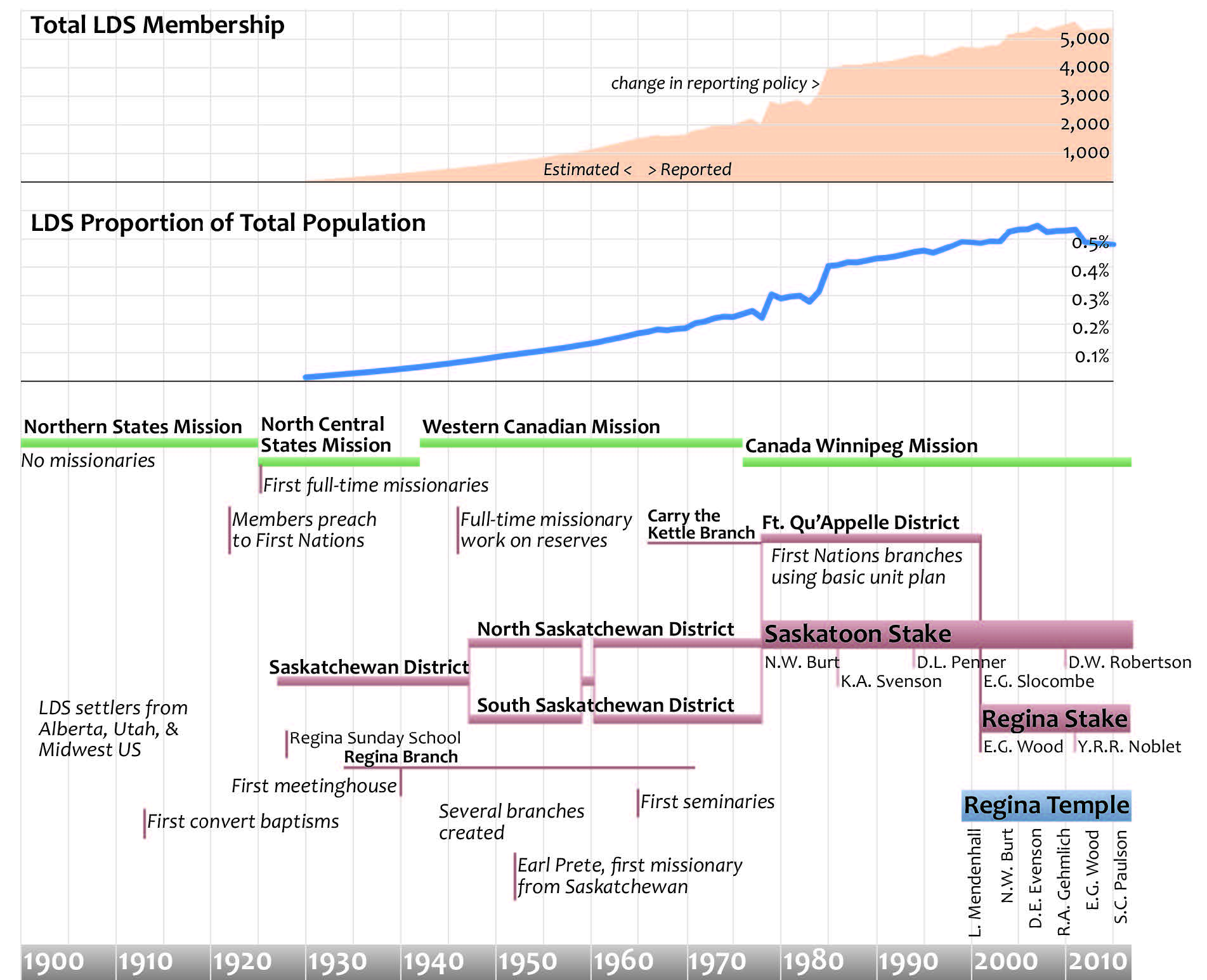 With only a few scattered members prior to the arrival of missionaries in 1925, the Church has grown in Saskatchewan to include two stakes and a temple.
With only a few scattered members prior to the arrival of missionaries in 1925, the Church has grown in Saskatchewan to include two stakes and a temple.
This influx of missionaries in the immediate postwar period permitted the expansion of missionary work into several new areas in Saskatchewan, including Shannon View, Silver Park, Nipawin, Tisdale, Mozart, Wilkie, and Biggar.[80] But, in December 1947, when British Columbia was added to the Western Canadian Mission, a number of missionaries were withdrawn from Saskatchewan to serve there. Of the newly opened areas, missionaries remained only in Shannon View and Silver Park.[81]
Extension of Work among First Nations
The year 1946 was also significant for missionary work among the First Nations of Saskatchewan. Two missionaries, Bud H. Hinckley and Lloyd H. Ashcroft, were assigned to conduct the first organized work on the Piapot, Muscowpetang, and Pasque Reserves.[82] Missionary work was also started on the Carry the Kettle Reserve.[83]
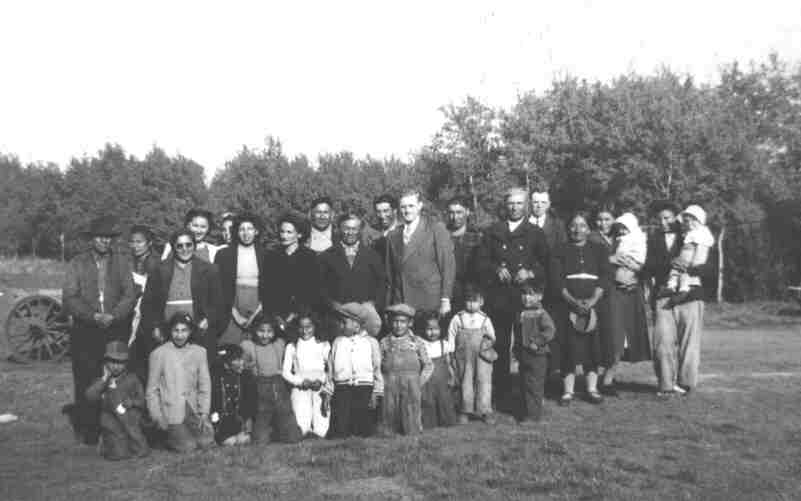 Sunday meeting on the Carry the Kettle Reserve, about 1949. A branch, formed in 1966, has continued to the present. (Loretta Spencer)
Sunday meeting on the Carry the Kettle Reserve, about 1949. A branch, formed in 1966, has continued to the present. (Loretta Spencer)
Missionary work on the reserves continued over the next few months, but there was opposition from other churches. The opposition reached a point where the Church felt it would be wise to secure official government approval. Hence, G. Gordon Whyte, president of the Saskatchewan District, and Abel Watech of the Piapot Reserve wrote letters in January 1947 to Cabinet Ministers in Ottawa, asking that the missionaries be allowed to continue working on the Piapot, Muscowpetung, and Pasqua reserves, as they had been for the past five months, and that they also be allowed to work on other reserves in the province. Five weeks later, on 15 February, Whyte received a letter from the Department of Mines, Resources, and Indian Affairs, saying that the government had “no objection” to LDS missionaries working on the reserves, provided they did not use lands or buildings on the reserves without proper permission.[84] The Church’s missionary work on the First Nations reserves of Saskatchewan now had the official sanction of the government of Canada.
On 11 and 12 August 1947, Antoine R. Ivins of the First Council of the Seventy and Glen G. Fisher, mission president, visited Saskatchewan, holding meetings on the Piapot Reserve on 11 August and on the Carry the Kettle Reserve on 12 August. Approximately 200 people attended each of the meetings; the vast majority of the congregations were not Church members.[85]
Missionary work progressed in the years that followed, and on 8 May 1966, the Carry the Kettle Branch was organized with Milton T. Davis, a missionary, as president and George O’Watch as a counselor. The first meetings of the Carry the Kettle Branch were held in the No. 2 School on the reserve.[86]
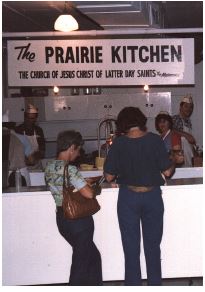 A common fund-raising project was a food concession at the local fair, and almost every branch/
A common fund-raising project was a food concession at the local fair, and almost every branch/
During the summer of 1966, First Nations Seminary was started on the Piapot, Carry the Kettle, and Cowesses Reserves. Classes were taught by the full-time missionaries and were held in private homes.[87] In 1970, the Indian Placement Program was instituted in Saskatchewan, whereby participating First Nations youth lived with LDS families in Alberta or British Columbia during the school year and returned to their parents on the reserves for the summers. This program gave better opportunities for education to the native children. Although not all participants had good experiences, some went on to attend university and serve missions. In many cases, participants became leaders in their communities.[88]
New Branches
Expansion of the Church continued in the postwar years. In June 1955, the Swift Current Branch was organized with Stewart F. Shields as president. Hugh B. Brown, an Assistant to the Twelve, attended the organizational meeting.[89] Meetings were originally held in a hall above Warren’s Funeral Home.[90]
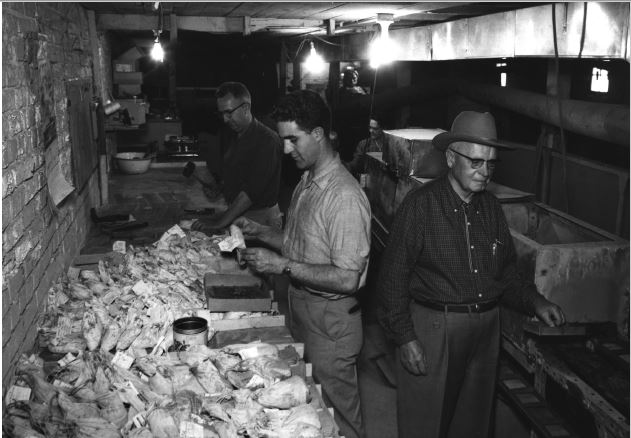 One of the unique fundraising projects in Regina was “core washing.” Several local Church members had connections with the oil industry, enabling branch members to work with that industry to prepare drilling core samples for laboratory analysis. This included washing, labelling, and packaging the samples. G. Gordon Whyte is at the right of the picture. Others include Bert Boyson and Grant Spackman. (Dan Morse)
One of the unique fundraising projects in Regina was “core washing.” Several local Church members had connections with the oil industry, enabling branch members to work with that industry to prepare drilling core samples for laboratory analysis. This included washing, labelling, and packaging the samples. G. Gordon Whyte is at the right of the picture. Others include Bert Boyson and Grant Spackman. (Dan Morse)
In 1959, two more branches were created—the Prince Albert Branch, with James H. McKay as president, and the Weyburn Branch, with Thomas Kemp as president.[91] In 1966, a branch was created in Yorkton, with Almon D. Owens, a missionary, as branch president; in 1967, the Kindersley Branch was formed, with E. Keith Campbell as president.[92] In 1972, the Battlefords Branch was organized, with Walter S. Elliott as president.[93]
Fund-Raising
The several branches throughout Saskatchewan, mostly meeting in dingy rented halls, dreamed of one day having their own Latter-day Saint meetinghouse. Each branch had to raise funds for its own operation and a significant share of costs for meetinghouse construction. Over a period of many years, extensive fund-raising helped to raise the local share. Most branches sponsored food booths at local fairs and exhibitions every year, with much success. Some branches, in addition to selling hamburgers, hot dogs, and french fries, also made and sold “spudnuts”—specialty doughnuts made from potato flour. Customers returned year after year. Branches in Regina and Saskatoon also had major projects to make and sell hand-dipped chocolates. The Regina Branch undertook a further fund-raising activity, cleaning, packaging, and labelling core samples from oil exploration drilling. All of these activities involved local Church members, men, women, and children, working together for a common goal. Funds from these activities not only went to building funds but also helped finance other operating expenses of the branches.[94]
New Chapels
In June 1958, construction began on a new meetinghouse in Regina. The first meetings in the new building were held on 21 December 1958. The former meetinghouse on Victoria Avenue was sold to a Mennonite group.[95]
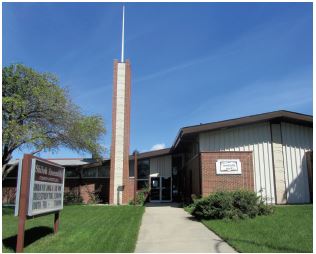 The construction of the Regina meetinghouse on Broadway Street in 1958, the first in the province built according to Church specifications, was an important milestone for the local Church members. It was sold to the Shiloh Assembly Church Apostolic when the new Regina Stake Centre was built in 1985. (Kenneth Svenson)
The construction of the Regina meetinghouse on Broadway Street in 1958, the first in the province built according to Church specifications, was an important milestone for the local Church members. It was sold to the Shiloh Assembly Church Apostolic when the new Regina Stake Centre was built in 1985. (Kenneth Svenson)
Sod-turning for the Saskatoon meetinghouse took place in September 1959, and in January 1960, the first meetings were held in the newly completed building. By September 1961, the one-phase building in Saskatoon was no longer adequate and the branch planned to add another phase.[96] The Saskatoon meetinghouse was dedicated by Delbert L. Stapley of the Quorum of the Twelve on 24 October 1965.[97]
Sunday, 29 August 1976 was an historic day for the Church in Saskatchewan, when Hartman Rector Jr. of the Seventy dedicated three chapels on the same day—the Prince Albert meetinghouse (thirtieth Street and fifth Avenue) at 9:30 a.m., the Melfort meetinghouse (610 Saskatchewan Avenue East) at 1:00 p.m., and the fourth phase of the Saskatoon meetinghouse (1429 tenth Street East) at 6:00 p.m.[98]
Further Growth and Expansion
The Church continued to grow and expand in succeeding decades. A milestone was reached when the Regina Branch was divided on 1 August 1971, with Albert Street dividing the two branches. The branch presidents at the time were Raymond M. Tondevold of the Regina First Branch, and John Smith of the Regina Second Branch.[99]
The first seminary class in Saskatchewan was held in Saskatoon on 27 September 1965 with twenty-three students.[100] Further growth was evidenced when the Saskatoon Branch was divided in November 1977, with E. Leroy Litchfield as the president of the Saskatoon First Branch and J. Blair Meldrum as the president of the Saskatoon Second Branch.[101]
A highlight of these years was the visit of Ezra Taft Benson of the Quorum of the Twelve to Saskatchewan in May 1977, where he attended a mission-wide youth conference at Fort Qu’Appelle, with youth from throughout Saskatchewan and Manitoba.[102]
Howard L. Lund
When the Canada Winnipeg Mission was created on 15 February 1976, with headquarters in Winnipeg, Manitoba, Saskatchewan became a part of that mission. The new mission president was Howard L. Lund, who provided energetic and pivotal leadership over the next three years. His goal was to have stakes created in both Manitoba and Saskatchewan and to see that each unit had a building suited to its needs.[105] Under Lund’s direction, branch building funds were combined and an ambitious building program was undertaken, including meetinghouse expansions in Regina and Saskatoon.[106] Lund addressed the need for adequate Church facilities on the First Nations reserves where regular meetings were being held. The Carry the Kettle Branch already had a portable building, but soon portable buildings were also located at the Punnichy, File Hills, and Piapot Branches.[107]
A special priesthood leadership meeting of the North Saskatchewan District was held on 29 August 1976, at which Hartman Rector, the visiting General Authority, promised the assembled leaders that, if the members of the district would faithfully do their missionary work, the district would become a stake within two years.[108] That promise was realized in just over two years.
Saskatoon Saskatchewan Stake and Fort Qu’Appelle Saskatchewan District, 1978– 97
The First Step to Stakehood
The Saskatoon Saskatchewan Stake was organized in two stages, separated by a period of nine months. The first stage took place on 11 and 12 March 1978, under the direction of Rex D. Pinegar of the Seventy, at a conference in Saskatoon for all Church members in Saskatchewan. During this conference, all branches in Saskatchewan—except for those on First Nations reserves and the Lamanite Branch in Regina—were combined into the Saskatoon Saskatchewan District. Noel W. Burt was appointed district president.[109] Branches in the district included Flin Flon (in Manitoba), Prince Albert, Battlefords, Saskatoon First and Second, Melfort, Kindersley, Swift Current, Moose Jaw, Regina First and Second, and Yorkton.[110]
During the same conference, those branches not included in the Saskatoon Saskatchewan District were organized into the Fort Qu’Appelle District (originally called the Lamanite District), with John P. Livingstone, a CES employee, as president and Christopher J. Lafontaine as counselor. The Fort Qu’Appelle District thus included the Regina Lamanite, Piapot, Carry the Kettle, Punnichy, File Hills, Kamsack, and White Bear Branches.[111]
In the Saskatoon Saskatchewan District, the next nine months were spent learning how to operate a fully staffed district organization that covered an entire province. The distance between the two major cities, Saskatoon (where the district president lived) and Regina (where one of his counselors lived), is 259 kilometres (161 miles). Some branches were at much greater distances, between three and five hundred kilometres from either centre. Holding some presidency and council meetings by teleconference and scheduling district events with a sensitivity to travel requirements, leaders developed ways to operate a district on a province-wide basis without unduly burdening the members.[112]
Formation of the Saskatoon Saskatchewan Stake
By the end of 1978, Church membership in Saskatchewan had reached 2,065.[113] On 5 November 1978, at the Centennial Auditorium in Saskatoon, the Saskatoon Saskatchewan Stake was organized, under the direction of L. Tom Perry of the Quorum of the Twelve. Noel W. Burt was appointed stake president, with Kent J. Cahoon (from Saskatoon) and Kenneth A. Svenson (from Regina) as counselors.[114]
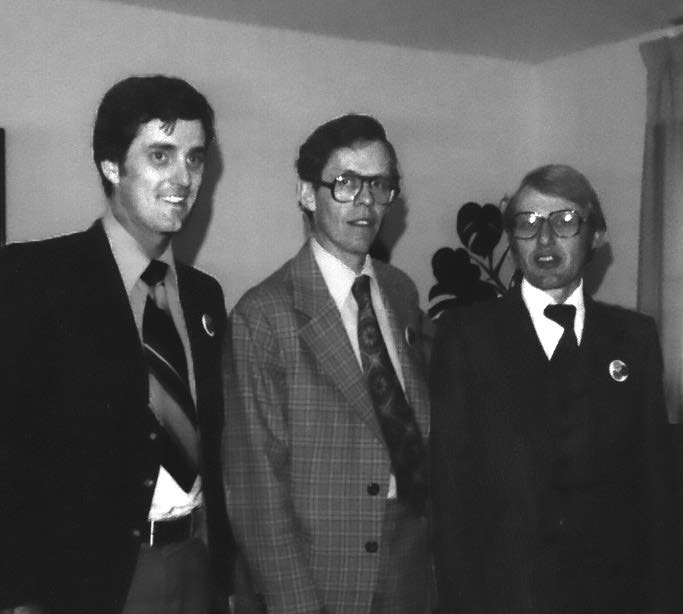 The first stake presidency of the Saskatoon Saskatchewan Stake, 1978. Left to right: Kent Cahoon, Noel Burt (president), Kenneth Svenson. The challenge of distances was immense for the new stake, which covered the entire province. Noel Burt recalls watching the aurora borealis on many late-night trips home from meetings. (Kenneth Svenson)
The first stake presidency of the Saskatoon Saskatchewan Stake, 1978. Left to right: Kent Cahoon, Noel Burt (president), Kenneth Svenson. The challenge of distances was immense for the new stake, which covered the entire province. Noel Burt recalls watching the aurora borealis on many late-night trips home from meetings. (Kenneth Svenson)
The new stake included five wards—Saskatoon First and Second, Regina First and Second, and Moose Jaw. It also included seven branches—Prince Albert, Battlefords, Kindersley, Melfort, Swift Current, Kisbey (Weyburn), and Yorkton.[115] At that time, the Flin Flon Manitoba Branch was taken from the Saskatoon Stake and was supervised directly by the Canada Winnipeg Mission.[116]
The stake became a blessing to the members, who began to grow in confidence and to feel more a part of the standard Church programs. Lives were strengthened, testimonies grew, and the commitment of the Saints to furthering the work of the Lord increased. By 1981, Church membership in Saskatchewan had reached 2,857.[117]
The history lists the names of a number of people who have served to assist the statistical growth of the Church in Saskatchewan, but many people who have contributed to that growth are not mentioned. Some of the people were originally residents of Saskatchewan and had their lives changed as the gospel of Jesus Christ came into their lives. Some have stayed and some have moved to other places where they have continued to contribute to the building of the kingdom of God on earth. Others were brought to Saskatchewan by the Lord, many from Alberta, and have made significant contributions there. The most important growth that has occurred has been the personal spiritual growth of the people. The Lord has touched the lives of many more people than are named in this history.
Growing Maturity
As the Church grew and matured in Saskatchewan, it expanded its programs and moved toward more community service. In January 1979, a family history centre opened in Saskatoon, with Arlene Lang as the director.[118] In the following years, family history centres were also opened in Moose Jaw, Regina, Kindersley, and Prince Albert.[119] It was not long before the genealogical societies in Saskatchewan became aware of this new resource, and soon there were more community members than Church members using the centres.[120]
“Come to Bethlehem,” a live nativity pageant, was sponsored by the LDS Church in Regina for ten years, beginning in the late 1970s. The event was housed in a large open area inside the Heritage Building, where Church members constructed and painted a sixty-foot set. The popular community event featured live cast and animals, sound and lighting, and was performed four times each evening for four days preceding Christmas. After a few years, a Nativity scene was also presented on the grounds of the provincial legislature. Many Church members, including the youth, participated in making these Nativity events successful and making the Church more visible in the community.[121]
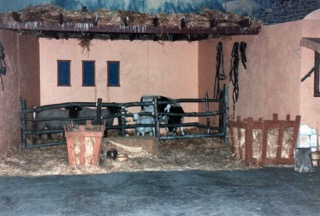 The popular Nativity Pageant, presented for several years in Regina, was an effective means to raise the visibility of the Church in the community and to emphasize the fact that The Church of Jesus Christ of Latter-day Saints is a Christian church. (Kenneth Svenson)
The popular Nativity Pageant, presented for several years in Regina, was an effective means to raise the visibility of the Church in the community and to emphasize the fact that The Church of Jesus Christ of Latter-day Saints is a Christian church. (Kenneth Svenson)
In October 1986, a group of twenty-five to thirty young women of the Saskatoon Saskatchewan Stake gathered at dawn at the Regina meetinghouse to participate with young women around the world in a worldwide celebration, “Arise and Shine Forth.” Each young woman, after fasting and prayer, had prepared personal messages of faith and testimony, which were attached to helium balloons and released.[122]
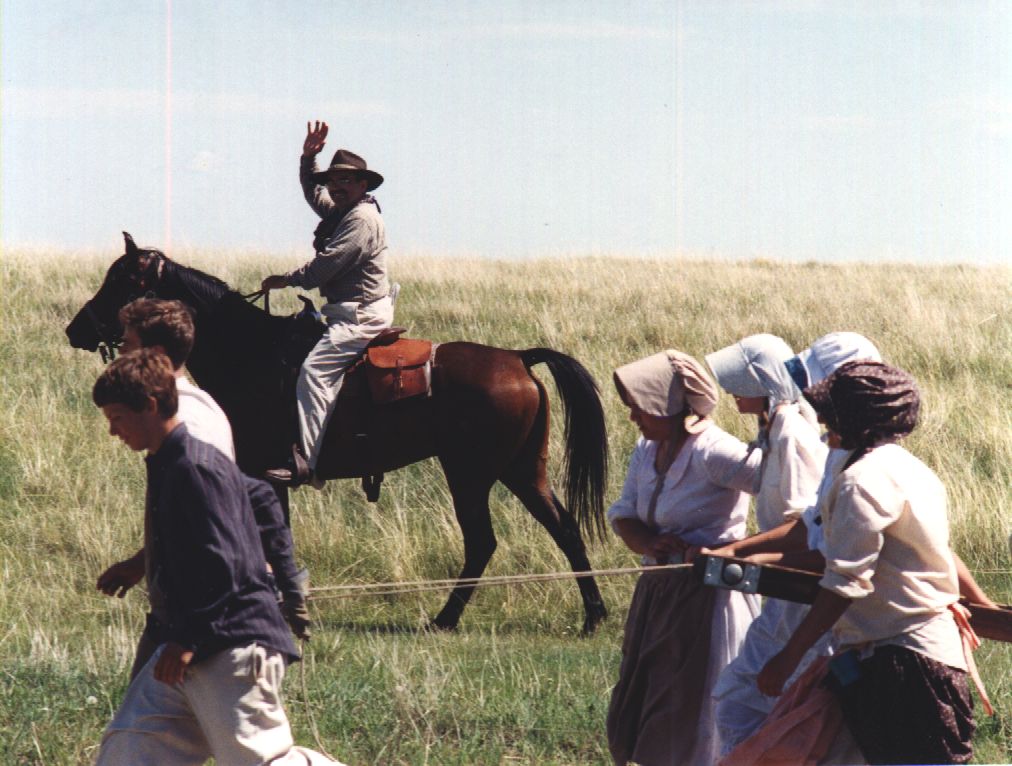 Youth of the Saskatoon Saskatchewan Stake participated in several pioneer trek experiences in which youth and adult leaders pulled handcarts for miles across the prairies and learned more of their pioneer heritage. The photographs show youth on the first stake pioneer trek in 1995, near Rosetown, Saskatchewan. (Kenneth Svenson)
Youth of the Saskatoon Saskatchewan Stake participated in several pioneer trek experiences in which youth and adult leaders pulled handcarts for miles across the prairies and learned more of their pioneer heritage. The photographs show youth on the first stake pioneer trek in 1995, near Rosetown, Saskatchewan. (Kenneth Svenson)
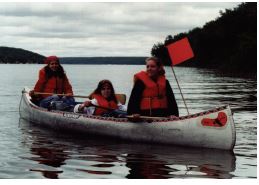 With about half of the Saskatoon Saskatchewan Stake in the northern boreal forest that includes the Churchill River watershed, there have been hundreds of opportunities for northern canoe trips, and many of the summer youth camps have included such activities. This photograph, taken in 1994, shows three young women on such an excursion. They are (L to R) Christie Evans, Carma Tiefenbach, and Betty Greff. (Kathleen Harker)
With about half of the Saskatoon Saskatchewan Stake in the northern boreal forest that includes the Churchill River watershed, there have been hundreds of opportunities for northern canoe trips, and many of the summer youth camps have included such activities. This photograph, taken in 1994, shows three young women on such an excursion. They are (L to R) Christie Evans, Carma Tiefenbach, and Betty Greff. (Kathleen Harker)
A growing number of local members embarked on full-time missions to various parts of the world. In 1987, there were twenty members of the Saskatoon Saskatchewan Stake serving full-time missions.[123] In 2003, after the division of the stake, eight full-time missionaries were serving from the Regina Saskatchewan Stake, and by 2012, that number had increased to fourteen missionaries in the field.[124] In 1998, young single adult branches were organized in Saskatoon and Regina, and the Regina Branch later became a ward. These units functioned for more than fourteen years until the young single adults were reintegrated into family wards.[125]
Technology greatly blessed Church members in Saskatchewan. General conference was received in Saskatoon and Regina by direct wire audio transmission in 1981, and by 1987, conference was being received by satellite.[126]
In recent years, LDS congregations have reached out further in service to their communities. For example, in 2010, a friendship and partnership began to develop between members of the Saskatoon Saskatchewan Stake and the Ahmadiyya Muslim Community (AMC). In the years that followed, the two groups have worked together in major community service initiatives, including food drives, blood drives, and clothing drives. The two groups have also held joint social and educational events, resulting in greater respect and understanding for one another’s beliefs.[127]
Application of the Basic Unit Program
Saskatchewan was featured in a June 1981 Ensign article on the Church’s new Basic Unit Program, which simplified administration, curriculum, and reporting for small branches. In the Fort Qu’Appelle Saskatchewan District, which had been created for First Nations branches in Saskatchewan, all branches used the basic unit program. Some of the experience gained in Saskatchewan was considered important for the Church across the world.[128]
The article quoted John P. Livingstone, former president of the Fort Qu’Appelle District, saying that the basic unit program was “like gearing the ninety-mile-an-hour Church down to twenty miles an hour. . . . It was basic enough that local men and women could actually see themselves as leaders.”[129] The article reported that the current president of the Fort Qu’Appelle District, Chris Lafontaine, and his counsellors, as well as three of the branch presidents, were First Nations men. Reactivation efforts were reaching people who had been less active for many years, and many new converts were being baptized. Attendance at Church meetings was increasing, and a few local young single adults had been called on full-time missions.[130]
While the basic unit program provided considerable short-term benefits, ultimately, the activity level in the Fort Qu’Appelle District languished for want of priesthood leadership, and several of the smaller branches were closed in the mid-1980s. When the Regina Saskatchewan Stake was formed in 2001, the Fort Qu’Appelle District was discontinued. The remaining First Nations branches, Carry the Kettle and Punnichy, became part of the new stake.[131]
Goal of Stake Division
By 1987, Church membership in Saskatchewan had increased substantially in six years—from 2,857 in 1981 to 4,161 in 1987, an increase of over 1,300. But, by 1990, Church membership growth in Saskatchewan had increased only marginally due to a downturn of the fluctuating Saskatchewan economy.[132]
When D. Lawrence Penner was appointed stake president in 1994, the stake implemented plans for stake growth, with a goal of dividing the stake by 2001. Stake leaders visited wards and branches to encourage the individual Church members to “pray for your kind of missionary experience.”[133] Baptisms in the stake in 1996 doubled those in 1995.[134] By year-end 1997, total Church membership in Saskatchewan had reached 4,541.[135]
Regina Saskatchewan Temple, 1998– 99
On 3 August 1998, Church President Gordon B. Hinckley and Boyd K. Packer, Acting President of the Quorum of the Twelve, visited Regina, where they spoke to 1,500 Saskatchewan Saints. E. Gregg Wood, then counsellor in the Saskatoon Stake presidency, recorded his memories of that pivotal event:
For the most part, [President Hinckley] spoke to the youth. Then, with about ten to fifteen minutes left, he . . . switched from speaking to the youth to the adults. His message was on temple work and temple attendance. Then he seemed to pause and ask, “You are a long way from Cardston, aren’t you?” He turned to President Packer and said something like, “What do you think, President Packer?” Then he turned back to the congregation and said something like, “We are happy to announce a temple in Regina.” Everyone sort of gasped and most eyes were no longer dry. What a thrill it was. I looked around and saw one inactive sister literally weeping.[136]
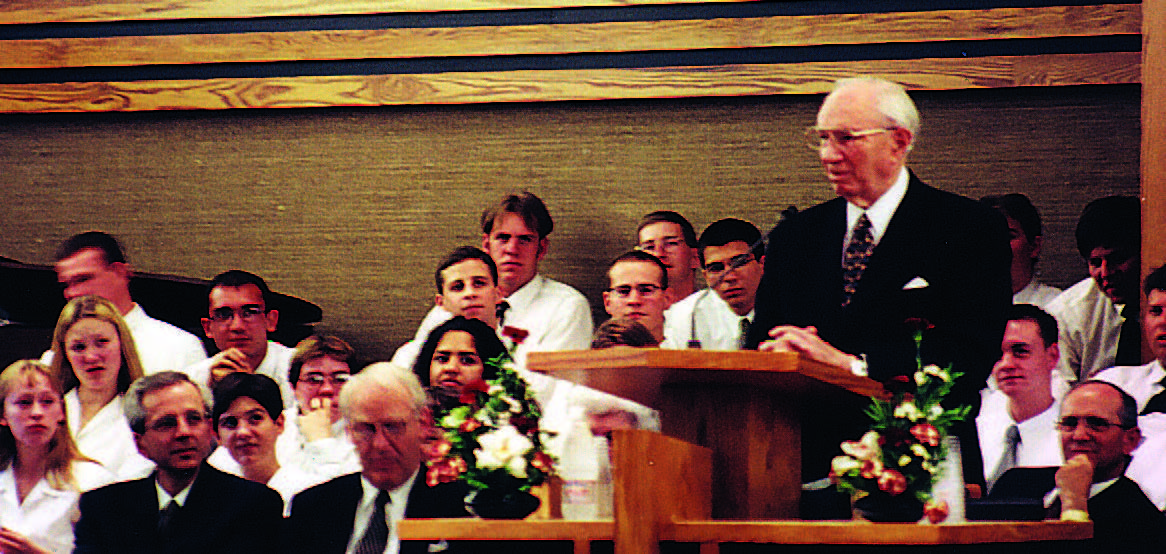 President Gordon B. Hinckley spoke in the Regina chapel on 3 August 1998, where he announced that a temple would be built in Regina. Seated behind President Hinckley are D. Lawrence Penner (Saskatoon Saskatchewan Stake president), Thomas Holt (Area Seventy), Dean Layton (president of the Canada Winnipeg Mission), and a young single adult choir from Regina. (Lawrence Penner)
President Gordon B. Hinckley spoke in the Regina chapel on 3 August 1998, where he announced that a temple would be built in Regina. Seated behind President Hinckley are D. Lawrence Penner (Saskatoon Saskatchewan Stake president), Thomas Holt (Area Seventy), Dean Layton (president of the Canada Winnipeg Mission), and a young single adult choir from Regina. (Lawrence Penner)
Ground was broken for the Regina Saskatchewan Temple on 14 November 1998. Construction proceeded rapidly, and the contractor expected the temple to be finished in September 1999. The public open house was set for 5 and 6 November 1999, with special pre-public tours beginning on the afternoon of 3 November. The dedication was scheduled for 14 November 1999—exactly one year from the groundbreaking.[137]
However, construction fell seriously behind schedule. On Tuesday, 2 November, the temple tower and its foundation structure still had no granite. The angel Moroni was not in place. Most of the stained glass windows were not installed, and a multitude of other things were unfinished. It seemed impossible that the tasks could be completed on time.[138]
Then on Wednesday morning, 3 November, a miracle happened. As the morning started there were still workers everywhere, but as they left each room, volunteer cleaners entered, and gradually, room by room, the temple was prepared for the open house. During this time, the last of the stained glass windows were installed. At 3:30 p.m. that day, when the first of the pre-public open house guests started to arrive, the cleaners were just pushing the last of the garbage out the back door. The building had changed from a work site into a temple.[139] The angel Moroni was placed on the tower at 5:00 p.m. Although hanging the exterior granite could not be finalized until the following week, the building was shrouded in such a way that it was difficult for most visitors to tell that the granite installation was not complete.[140] In all, 8,640 people visited during the open house, and reactions to the tours were very positive.[141]
By 12 November 1999, two days before the dedication, granite installation and other final preparations for the temple dedication were close to completion, but the temple was still surrounded by bare earth. The landscaper had been unable to find any sod in the area at that time of year. Finally, someone located sod in North Battleford, about 395 kilometres (245 miles) away. The sod was ordered and cut (a miracle in itself because the ground is usually frozen solid in November), a truck picked it up, and it was delivered to the temple site at 7:00 a.m., Saturday, 13 November. At 8:00 a.m., about eighty Church members and forty to sixty full-time missionaries began laying sod. They were done in two and a half hours.[142]
Meanwhile, not all of the dedication-related problems were occurring in Regina. President Gordon B. Hinckley had been scheduled to dedicate the Halifax Nova Scotia Temple on Saturday, 13 November, after which he would fly to Regina to dedicate the Regina Temple the following day. However, because of mechanical problems with President Hinckley’s plane, it was necessary to move the Halifax temple dedication to 14 November. Thus, on 14 November 1999, while President Hinckley dedicated the Halifax Nova Scotia Temple, Boyd K. Packer, Acting President of the Quorum of the Twelve, dedicated the Regina Saskatchewan Temple. This was the first time in the history of the Church that two temples were dedicated on the same day.[143] President Packer led three dedicatory sessions, reading the dedicatory prayer which had been written by President Hinckley. A total of 2,020 people were in attendance.[144]
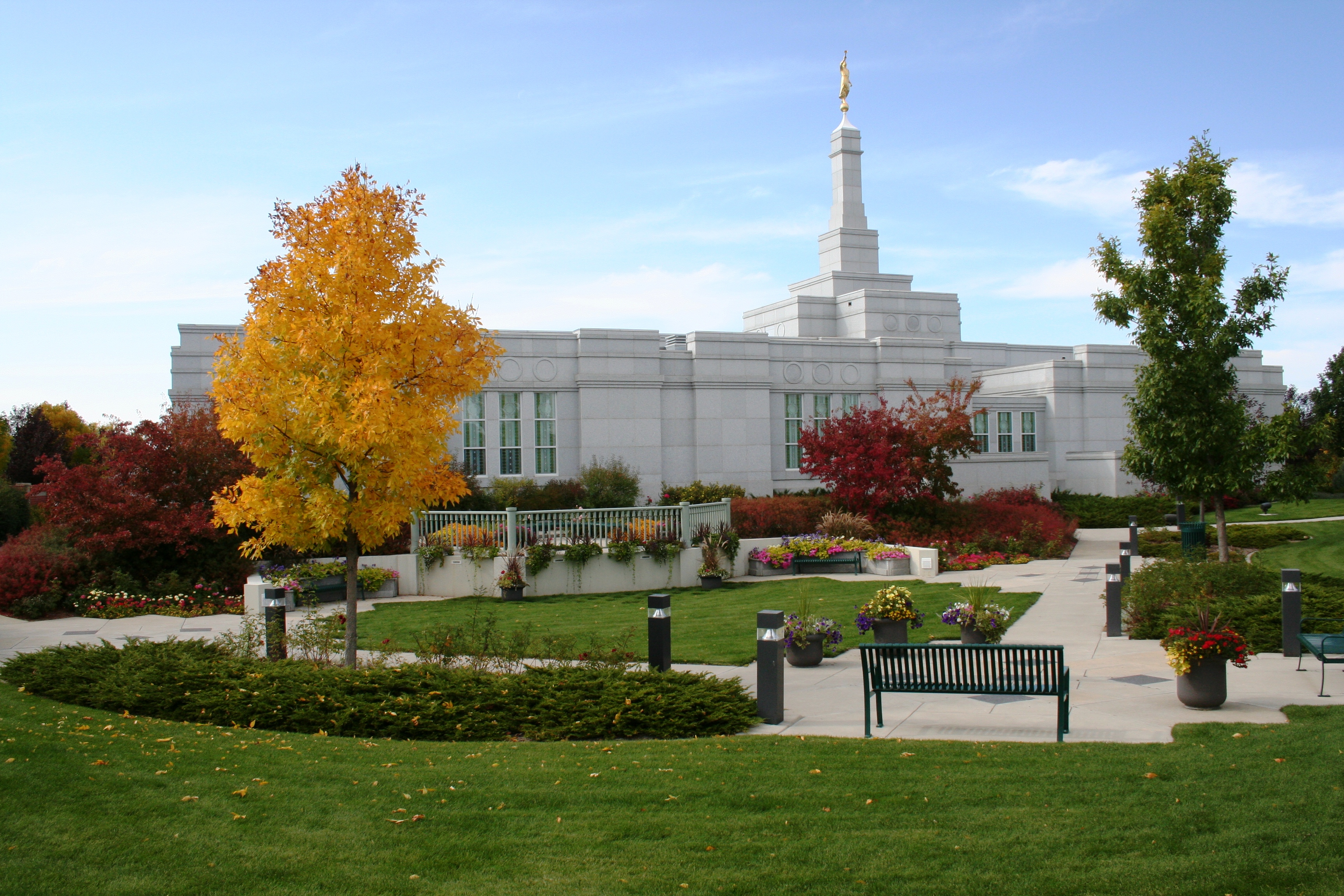 Regina Saskatchewan Temple, with autumn leaves. The temple represents the fulfillment of the aspirations of many people. It is a symbol of the permanence and growing spiritual maturity of the Church in Saskatchewan. (E. Dahl Quinton)
Regina Saskatchewan Temple, with autumn leaves. The temple represents the fulfillment of the aspirations of many people. It is a symbol of the permanence and growing spiritual maturity of the Church in Saskatchewan. (E. Dahl Quinton)
Lorin J. Mendenhall and his wife, Mildred, of Welling, Alberta, were called as temple president and matron, with Jack and Karen Oviatt and Allan and Ruth Shaver as counselors and assistant matrons.[145] With a newly trained staff, the temple opened as scheduled on Monday, 15 November, at 10:00 a.m. for three sessions, and continued on a regular schedule of eight sessions per week.[146] The ordinances and the blessing of a local temple became a part of life for the Fort Qu’Appelle District and the Saskatoon Saskatchewan and Winnipeg Manitoba Stakes.[147] It was a time of rejoicing! No longer would faithful Saints have to travel the long distance to the Cardston Alberta Temple to receive sacred ordinances of the gospel.
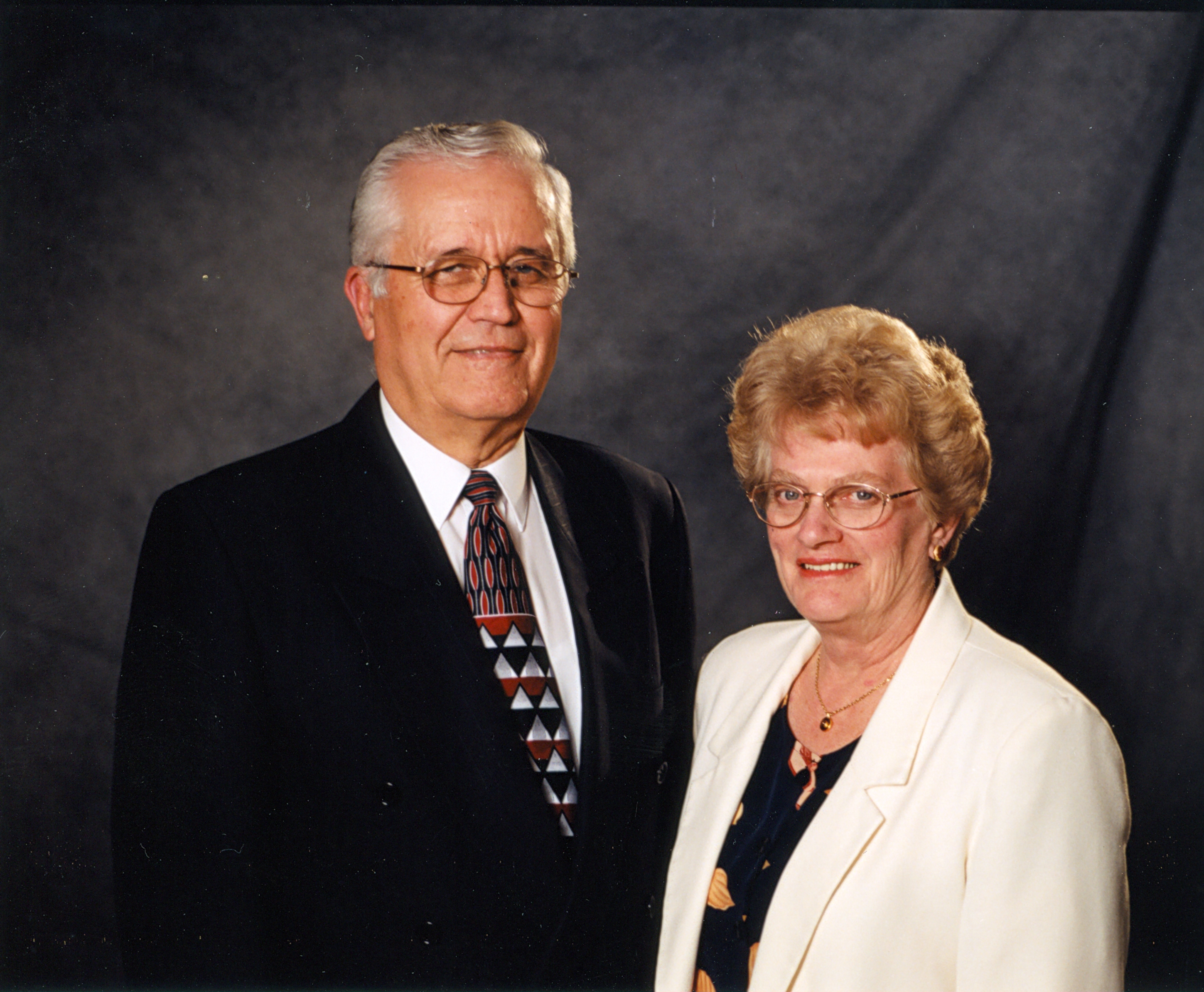 The first president and matron of the Regina Saskatchewan Temple, Lorin and Mildred Mendenhall, were from Welling, Alberta. They began their four years of service in 1999. (Ron Goetz)
The first president and matron of the Regina Saskatchewan Temple, Lorin and Mildred Mendenhall, were from Welling, Alberta. They began their four years of service in 1999. (Ron Goetz)
Two Stakes Formed, 2000–2002
By 2000, Church membership in Saskatchewan had reached 4,794, and the time had come to divide the geographically large Saskatoon Saskatchewan Stake.[148] However, there were not enough priesthood leaders and wards to create two stakes. It was decided to create a stake in Regina, in the southern part of the province, and to organize the more northerly Saskatoon area as a district. These changes were scheduled to occur during a stake conference on 15–16 September 2001, with Bruce C. Hafen of the Seventy presiding. But, because of the disruption of air travel caused by the 9/
In the September 2001 conference, in preparation for the pending division of the stake, the Fort Qu’Appelle District was dissolved, with the units of the district becoming part of the stake; the Yorkton Branch was discontinued; and the boundaries of the Regina wards were readjusted.[150]
Division of the Saskatoon Saskatchewan Stake
On Saturday afternoon, 27 October 2001, Russell M. Nelson of the Quorum of the Twelve presided at the organizational meeting of the new Regina Saskatchewan Stake, appointing E. Gregg Wood as stake president, with Terence P. Hawkes and Charles A. Shugart as counselors. The Regina Saskatchewan Stake included five wards (Lewvan, Mount Pleasant, University, Wascana—realigned and renamed units in Regina—and Moose Jaw) and four branches (Carry the Kettle, Punnichy, Weyburn, and Swift Current).[151]
In Saskatoon the following day, the plan had been to dissolve the Saskatoon Saskatchewan Stake and to organize a new district in its place. During the interviews preliminary to selecting a president for the anticipated Saskatoon Saskatchewan District, Elder Nelson left the room for private prayer. Upon his return, the interviews proceeded and Eric G. Slocombe was called “to preside over the saints in this part of the Lord’s vinyard.”[152] Slocombe selected Milton R. Derry and G. Blaine Jensen as counselors.[153]
During the business part of the conference, Elder Nelson released all the officers of the old Saskatoon Saskatchewan Stake and then said, “Under inspiration and revelation of Almighty God, to which I am obedient, I present for your sustaining vote the following brethren to preside over you in this the Saskatoon Saskatchewan Stake of Zion.’”[154] The presidency was then sustained. It took a moment or two for people to realize that the Saskatoon Saskatchewan Stake was to continue. There were many feelings and tears of joy. The Saints in northern Saskatchewan had come expecting to be made a district, an event they were prepared to accept but viewed as a step backward because, as Elder Nelson expressed in his talk during the meeting, “stakes are places of spiritual refuge and safety.”[155] Nelson noted that the “Saskatoon Stake did not qualify in any way to be made a stake,” with only three wards and six branches, but that he “felt strongly that the people needed the safety of a stake in these troubled times.”[156] Because of the lack of time to conduct interviews, a whole new slate of stake officers was called from the pulpit.[157]
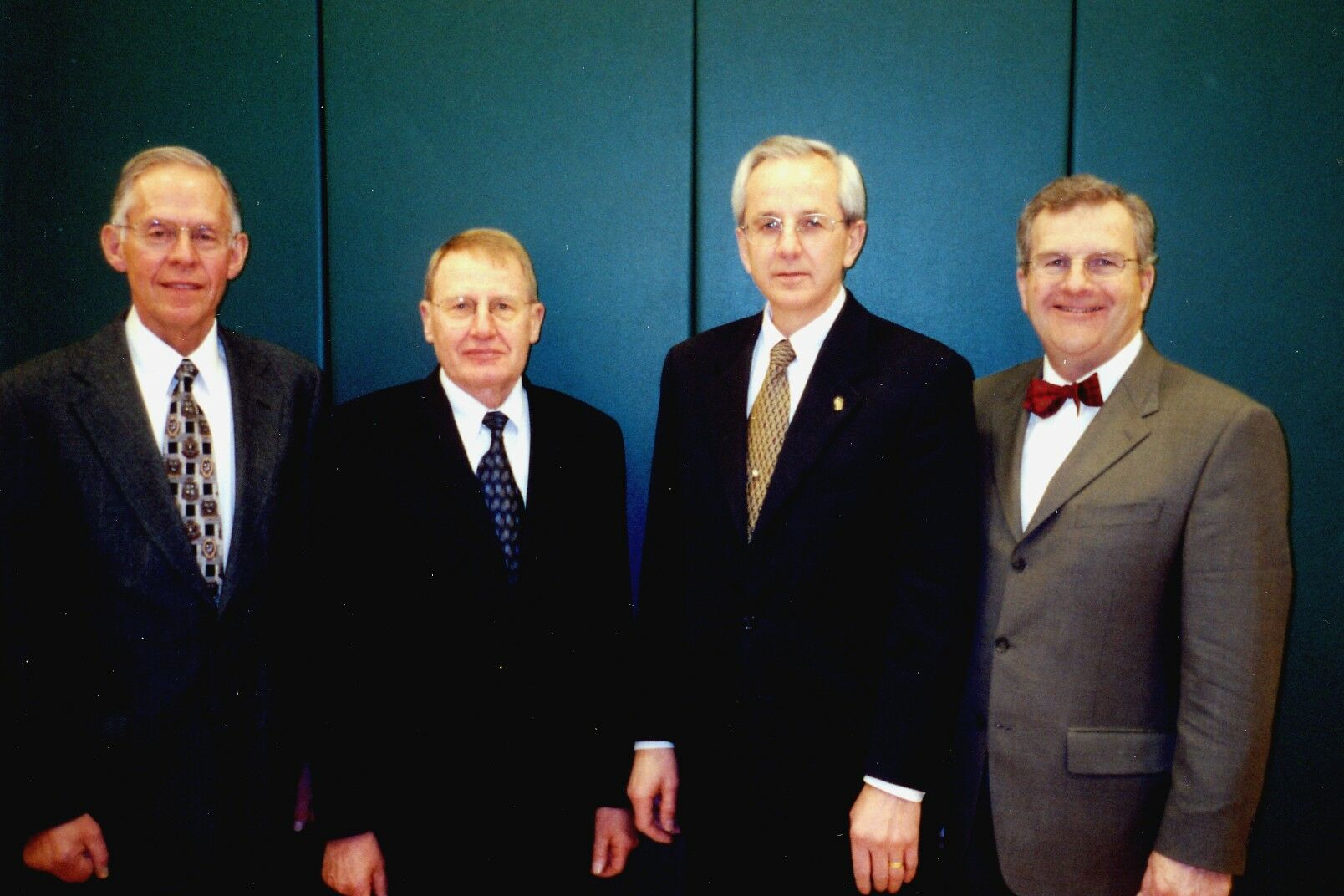 Four men served as presidents of the Saskatoon Saskatchewan Stake between 1978 and 2003. This photograph was taken at the twenty-fifth anniversary celebration of the stake in 2003. The four presidents are standing left to right in order of service: Noel Burt, Kenneth Svenson, Lawrence Penner, and Eric Slocombe. (Kenneth Svenson)
Four men served as presidents of the Saskatoon Saskatchewan Stake between 1978 and 2003. This photograph was taken at the twenty-fifth anniversary celebration of the stake in 2003. The four presidents are standing left to right in order of service: Noel Burt, Kenneth Svenson, Lawrence Penner, and Eric Slocombe. (Kenneth Svenson)
“How Did We Do It?”
In 2001, D. Lawrence Penner, recently released president of the original Saskatoon Saskatchewan Stake, which covered the entire province, reflected on the progress the stake had made and weighed the factors that allowed the Church to survive and grow in spite of the vast distances involved. He concluded that technology was an important element, allowing conference calls to replace some in-person meetings. Penner also pointed to the faithfulness and dedication of the leaders and members. He cited inspiring examples, including Guy Sabey of the Kindersley Branch. Sabey regularly drove three hours each way to high council meetings in Saskatoon and four hours each way when those meetings were held in Regina. Penner noted that Sabey never complained and was rarely absent. Ultimately, Penner averred, it was the Lord who did the work.[158]
Leaders of the original Saskatoon Saskatchewan Stake had tried various formats for stake conferences. Sometimes they alternated locations, holding one conference in Saskatoon and the next one in Regina. Sometimes they held sessions simultaneously in both locations, with a member of the stake presidency presiding at each session. On at least one occasion, the proceedings of the conference in Regina were transmitted via direct wire to a congregation in Saskatoon.[159]
Growth in Saskatchewan Stakes
Following the stake division, success in missionary work and reactivation was noted in the Regina Stake, with attendance at the Carry the Kettle Branch reaching eighty, and the Swift Current Branch qualifying for remodeling of their meetinghouse.[160] The Melville Branch (later renamed the Yorkton Branch) was created in 2008. In the Saskatoon Stake, a second building, the Fairmont meetinghouse, was dedicated in Saskatoon in 2003.[161] This was the first city in Saskatchewan to have more than one meetinghouse. The Meadow Lake Branch was organized in northwestern Saskatchewan in 2008.[162] By 2015, the Saskatoon Stake had four wards and five branches (including a branch in Flin Flon, Manitoba), and the Regina Stake had four wards and four branches.[163]
The map at the beginning of the chapter shows Church units in Saskatchewan as of 2016. By the end of 2015, total membership in the province had grown to 5,454.[164]
Conclusion
The Church in Saskatchewan has grown from a few scattered members in the early 1900s to two stakes and a temple that bless the lives of the current members. This growth has not been spectacular but it has been steady. Church growth in Saskatchewan has been filled with incidents that might be called miracles. The two stakes were created in spite of the lack of statistical qualification, and the building of the Regina Saskatchewan Temple was a gift from the Lord, given the relatively small number of members in the province. The most significant growth, however, has been the result of individuals and families allowing the Lord to work in their lives. The Lord changes people and he can then bring about the institutional growth that supports additional individual growth. The hand of the Lord is in all growth, personal or institutional, and has truly been manifest in the establishment and progress of the Church in Saskatchewan.
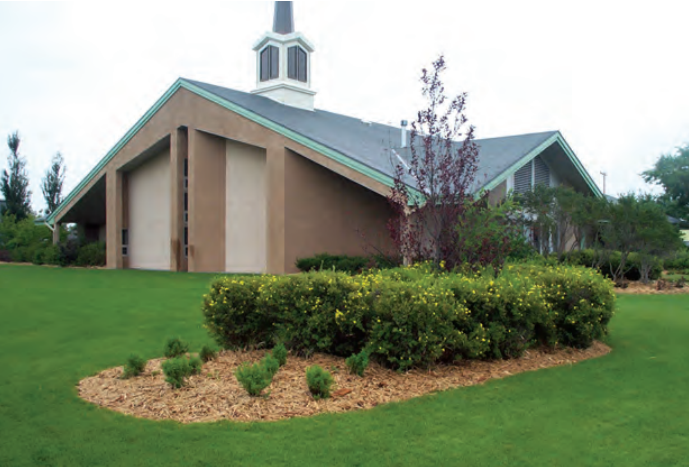 The second meetinghouse in Saskatoon is located at 339 Fairmont Drive, Saskatoon, and was dedicated in 2003. Saskatoon was the first city in Saskatchewan to have two operating meetinghouses. (Kenneth Svenson)
The second meetinghouse in Saskatoon is located at 339 Fairmont Drive, Saskatoon, and was dedicated in 2003. Saskatoon was the first city in Saskatchewan to have two operating meetinghouses. (Kenneth Svenson)
Building upon the solid foundation of early faithful members, such as G. Gordon Whyte, and a host of others who have served faithfully over the years, the Church in Saskatchewan has grown and progressed, despite the challenges of remote branches, long distances, severe weather, and a fluctuating economy. The Regina Saskatchewan Temple continues to bless Church members, providing an anchor to their lives and a spiritual focal point for Latter-day Saints in the province. The temple is a symbol of the growing maturity of the Church in Saskatchewan and a beacon light to the rising generation.
Notes
[1] Much material for this chapter has been taken from Kenneth Svenson and Brook Harker, eds., The Hand of the Lord: A History of The Church of Jesus Christ of Latter-day Saints in Saskatchewan (Saskatoon Saskatchewan and Regina Saskatchewan Stakes, [2014]). The author expresses his appreciation to Carma T. Prete, whose research on the Saskatchewan history “Profile,” in 2014–15 at the Church History Library in Salt Lake City, Utah, has been integrated into the chapter.
[2] “Homesteading,” Saskatchewan Archives Board, www.saskarchives.com.
[3] Alan Anderson, “Population Trends,” The Encyclopedia of Saskatchewan, http://
[4] Jennett Williams, KWJ1-Y4Q, www.familysearch.org; 1911 Census of Canada, Saskatchewan, Moose Jaw district 211, subdistrict 4; Saskatchewan Homestead Index, Abner Lynd, www.saskhomesteads.com.
[5] Marlene Breti, “Englesby Family,” in Svenson, Hand of the Lord, 212.
[6] Ida Amalia Peterson, KWJF-7VR, www.familysearch.org; 1916 Canadian Census for Manitoba, Saskatchewan, and Alberta, Saskatchewan, District 23, Enumeration District 20, Twp. 20, R. 20, W. 2; 1921 Census of Canada, Saskatchewan, District 221, Enumeration District 37, Marquis Municipality.
[7] Alfred Bowden (KWJ7-QL4), Edith Rebecca Hunt (KWJD-N4Z), and Ethel Annie Bawden (KW8F-7KS),familysearch.org; 1911 Census of Canada, Saskatchewan, District 208, Battleford, Enumeration district 6, Twp. 20, R. 24, W3.
[8] 1911 Census of Canada, Saskatchewan, Moose Jaw, Dist. 211, Subdist. 130; Valentine Knechtel, KWJ4-NRK,familysearch.org; Henderson’s Moose Jaw Alphabetical Directory for 1912, 282; Svenson, Hand of the Lord, 10.
[9] Journal of George Gordon Whyte, 17 August 1913. The original journal is in the possession of Gary Ursenbach of Calgary, Alberta. Microfilm copies are available in the Regina Saskatchewan Family History Centre and at the Church History Library in Salt Lake City.
[10] Journal of GG Whyte, cited in Svenson, Hand of the Lord, 11.
[11] Naida Rose Isfeld Little, Memories of the Life of Joel August Isfeld, Cardston, Alberta. A copy is in possession of Wayne Tiefenbach of Regina, Saskatchewan.
[12] Journal of GG Whyte, 1 June, 7 July 1919.
[13] Audur Emilia Thordorson (KWZV-47X) and Carl Jacob Rollefson (KWJ6-YKL), www.familysearch.org; Record of Members, Raymond Second Ward, 1912–43, Family History Library (hereafter FHL) film #105381.
[14] Journal of GG Whyte, 2 and 24 October 1924.
[15] South Saskatchewan District General Minutes (hereafter SSDGM), 8–10 November 1925, 4, Church History Library (hereafter cited as CHL), LR 15430 11.
[16] Record of Members, Raymond First Ward, 1901–1942, FHL film #105380; Record of Members, Raymond Second Ward, 1912–1943, FHL film #105381.
[17] Record of Members, Manitoba District, Northern States Mission, Early to 1919, FHL film #105331.
[18] Journal of GG Whyte, 29 October 1922.
[19] Journal of GG Whyte, 29 October 1922.
[20] Journal of GG Whyte, 29 October 1922.
[21] Victor Waddoups, “Regina Mutual, Saskatchewan, Canada,” Improvement Era, July 1939, 432–33.
[22] Journal of GG Whyte, 27 November 1927.
[23] SSDGM, folder 1, 23 July 1925, CHL, LR 15430 11.
[24] Journal of GG Whyte, 28 August 1925; SSDGM, 18, 23 July 1925, 1, CHL, LR 15430 11.
[25] North Central States Mission, Minnesota Minneapolis Mission Manuscript History and Historical Reports (hereafter cited as NCSM, MMMMHHR), box 1, vol. 1, part 1, folder 1, 6 August 1925, CHL, LR 6151 2.
[26] Flora Englesby, letter to E. J. Wood, n.d., in Liahona, the Elders’ Journal, 29 June 1926, 24.
[27] SSDGM, folder 1, 3–24 Sept. 1930, 95–96, CHL, LR 15430 11; Liahona, the Elders’ Journal, 9 December 1930, 307–8.
[28] SSDGM, folder 1, 1925–31, CHL, LR 15430 11; Saskatchewan District General Minutes (hereafter cited as SSDGM), folder 1, 1934–46, CHL, LR 17713 11.
[29] NCSM, MMMMHHR, box 1, vol. 1, part 1, folder 1, 18–19 March 1926, CHL, LR 6151 2.
[30] Journal of GG Whyte, 19 March 1926. John G. Allred was then president of the North Central States Mission (Liahona, the Elders’ Journal, 4 May 1926, 453).
[31] Journal of GG Whyte, 14 June 1928.
[32] SSDGM, folder 1, 5, 12, and 19 June 1927, 18–19, CHL, LR 15430 11.
[33] Journal of GG Whyte, 19 June 1927.
[34] NCSM, MMMMHHR, box 1, vol. 1, part 1, folder 1, 8 May 1927, CHL, LR 6151 2.
[35] Journal of GG Whyte, 25 Feb 1928, 20 May 1928, 10 Jun 1928, 14 Jun 1928.
[36] Sylvia DeLaysaac, “Chronological History of the Church in Moose Jaw,” Hand of the Lord, 164.
[37] NCSM, MMMMHHR, box 1, volume 1, part 2, folder 2, 9 November 1930, CHL, LR 6151 2.
[38] SSMGM, 18, 23 July 1925, 4–5 September 1925, 1–2, CHL, LR 15430 11; NCSM, MMMMHHR, box 1, vol. 1, part 1, folder 1, 30 May 1927, CHL, LR 6151 2.
[39] NCSM, MMMMHHR, box 1, v. 1, pt. 1, folder 1, 17 August 1927, CHL, LR 6151 2; Mae Cornelia Englesby, KWCQ-4NB, Harrison Washington Englesby, KW8K-HTH, and Florabell Naomi Englesby, KWDL-2M1, www.familysearch.org.
[40] NCSM, MMMMHHR box 1, vol. 1, part 2, folder 2, 31 December 1930, CHL, LR 6151 2; Mae Cornelia Englesby, KWCQ-4NB, and Mary Isabel Prete, KW8N-DBQ, www.familysearch.org.
[41] Record of Members, North Saskatchewan District, North Central States Mission, Early to 1930, FHL film #0105336, extracted by Kenneth G. Aitken, 28 August 2003.
[42] RBGM, folder 1, 27 May 1934, 78–79, CHL, LR 7399 11.
[43] Lethbridge Stake, A History of the Mormon Church in Canada (Lethbridge: The President of the Lethbridge Stake, A Corporation Sole, 1968), 278.
[44] NCSM, MMMMHHR, box 1, vol. 2, part 1, folder 4, 5, and 8 September 1938, CHL, LR 6151 2.
[45] Journal of GG Whyte, 28 May 1939; Victor Waddoups, “Saskatchewan District,” Liahona, the Elders’ Journal, 27 June 1939, 44–45; Dorothy Paine, “Everyone Suddenly Seemed Much Closer–May 28, 1939,” in Svenson, Hand of the Lord, 32.
[46] Western Canadian Mission, Canada Calgary Mission Manuscript History and Historical Reports (hereafter cited as WCM, CCMMHHR), box 1, vol. 2, folder 2, Quarterly Historical Reports, 31 December 1959, CHL, LR 10539 2.
[47] George Gordon Whyte and Walter P. Van Moorlehem to Pres. W. W. Richards, 23 December 1936, RBGM, folder 1, CHL, LR 7399 11. Regina Branch General Minutes, folder 1, 19 May 1935, 104, CHL, LR 7399 11.
[48] RBGM, folder 2, 14–15 April, 19 May, and 23 June 1940, 35, 37, 41–50, CHL, LR 7399 11; Journal of GG Whyte, 14 April and 19 May 1940.
[49] Elizabeth Mooney, “Great Depression,” The Encyclopedia of Saskatchewan, www.esask.uregina.ca.
[50] Carol Cornwall Madsen, “The Christian Way,” Church News, 1 July 1978, 16.
[51] Regina Branch General Minutes (hereafter cited as RBGM), folder 1, 11, and 17 April 1947, folder 2, 5 December 1943, 25 August 1944, 23 March 1945, CHL, LR 7399 11.
[52] Victor Waddoups, “Regina Mutual, Saskatchewan, Canada,” Improvement Era, July 1939, 433.
[53] Journal of Alan C. Halsted, 31 October 1937, in the possession of M. Bruce Halsted of Calgary, Alberta.
[54] SSDGM, 29 February 1944, 194–95, CHL, LR 17713 11.
[55] Program, Dedicatory Services, Saskatoon Meetinghouse, Third Phase, copy in possession of Kenneth A. Svenson; Lethbridge Stake, Mormon Church in Canada, 280.
[56] SSDGM, 29 May 1946, 241, CHL, LR 17713 11.
[57] Moose Jaw Branch General Minutes, 1 December 1946, 3, CHL, LR 5764 11.
[58] SSDGM, 12 October 1940, 100–101, CHL, LR 17713 11; North Saskatchewan District general minutes (hereafter cited as NSDGM), 16 November 1947, 11, CHL, LR 15431 11.
[59] SSDGM, 25 May 1946, 240, CHL, LR 17713 11.
[60] Carma T. Prete, “We Do Not Doubt Our Mothers Knew It”: Latter-day Saint Pioneers in the Shannon View Saskatchewan Area, 1905–1969 (Salt Lake City: Digital Legend Press, 2016), vii, 61–70. Numbers compiled from information provided by family historians, Marva Jean Brown, Sandra Preete Sutton, and Ione Prete Nysetvold (83, nn. 1–2).
[61] Roy A. Prete, “Observation,” 18 September 2015, unpublished, in possession of Roy A. Prete.
[62] NSDGM, 4 January 1950, 97, CHL, LR 15431 11.
[63] NSDGM, folder 1, 1 July 1947, 1, CHL, LR 15431 11.
[64] NSDGM, 19 September 1948, 34–35, CHL, LR 15431 11; Victor Clark, “Victor and Verna Clark,” in Svenson, Hand of the Lord, 208.
[65] WCM, CCMMHHR, box 1, vol. 2, folder 2, 25 August 1957, CHL, LR 10539 2.
[66] Mrs. Calvin Fife, “Elder Calvin Fife, Full-time Missionary in Saskatchewan,” in Svenson, Hand of the Lord, 215.
[67] Reed Smith, interview with Roy A. Prete, 1 April 2015. Smith served as a missionary in both locations in the late 1940s.
[68] Www.worldweatheronline.com/
[69] WCM, CCMMHHR, box 1, volume 2, folder 1, 31 December 1955, CHL, LR 10539 2.
[70] See Prete, “We No Not Doubt Our Mothers Knew It,” 9.
[71] RBGM, folder 2, 8–9 September 1945, 226–31, CHL, LR 7399 11.
[72] RBGM, folder 2, 23 November 1939, 15, CHL, LR 7399 11.
[73] SSDGM, folder 1, 12–24 October 1944, 213–14, CHL, LR 17713 11.
[74] RBGM, folder 2, 8–9 September 1945, 226–31, CHL, LR 7399 11; Vernon Claude Arnold, KWJ4-TLX, www.familysearch.org.
[75] SSDGM, folder 1, 15 August and 15 September 1940, 90, 93, CHL, LR 17713 11.
[76] RBGM, folder 2, 23 March 1941, CHL, LR 7399 11; “The Churches,” Cairns Post, 22 March 1941, 3.
[77] Janet Hamilton Boucher Life Story, 18n17, Janet Leah Hamilton (KWZQ-BWC), www.familysearch.org.
[78] RBGM, folder 2, 23 March 1941 to 1 February 1942, 78–108, CHL, LR 7399 11; Rachel Lea Heide and Ross Herrington, “British Commonwealth Air Training Plan,” Chart showing BCATP Schools in Saskatchewan, The Encyclopedia of Saskatchewan, http://
[79] Wilbur Gordon Hackney, “History of the Western Canadian Mission” (master’s thesis, Brigham Young University, 1950), 73, 78, 86, 96, 135.
[80] Western Canadian Mission History (hereafter cited as WCMH), folder 1, 28 April 1946–22 November 1947, CHL, LR 10539 27.
[81] NSDGM, 5 December 1947, 13–14, CHL, LR 15431 11.
[82] SSDGM, 7, 18 August, 12 September, 13 October 1946, 243–45, 247–49, 251, CHL, LR 17713 11.
[83] WCMH, 11–12 August 1947, 130, CHL, LR 10539 27.
[84] Journal of GG Whyte, 15 February 1947; WCMH, 16 February 1947, 122, CHL, LR 10539 27.
[85] SSDGM, folder 2, 11–12 August 1947, CHL, LR 15430 11.
[86] Lethbridge Stake, Mormon Church in Canada, 279.
[87] Lethbridge Stake, Mormon Church in Canada, 276–77, 279.
[88] Svenson, “Indian Placement Program (1970–85),” Hand of the Lord, 107–08.
[89] WCM, CCMMHHR, box 1, vol. 2, folder 1, June 1955, CHL, 10539 2.
[90] Lethbridge Stake, Mormon Church in Canada, 278.
[91] WCM, CCMMHHR, box 1, vol. 2, folder 2, 27 September and 4 October 1959, CHL, LR 10539 2.
[92] Yorkton Branch General Minutes, folder 1, n.d., CHL, LR 10330 11; Kindersley Branch Manuscript History and Historical Reports, folder 1, cover sheet and 4 June 1967, CHL, LR 4453 2.
[93] WCM, CCMMHHR, box 2, vol. 5, folder 1, 26 November 1972, CHL, LR 10539 2.
[94] Svenson, Hand of the Lord, 143–45.
[95] WCM, CCMMHHR, box 1, v. 2, folder 2, 30 June 1958 and 31 December 1958, and folder 1, 30 September 1955, CHL, LR 10539 2.
[96] WCM, CCMMHHR, box 1, v. 2, folder 2, 30 September 1959, and box 2, v. 3, folder 1, 31 March 1960 and 30 September 1961, CHL, LR 10539 2.
[97] WCM, CCMMHHR, box 2, v. 4, folder 1, 31 December 1965, and folder 2, 30 June 1967, CHL, LR 10539 2.
[98] North Saskatchewan District Manuscript History and Historical Reports (hereafter cited as NSDMHHR), folder 1, 29 August 1976, CHL, LR 6193 2; Dedicatory Service Programs for Melfort, Prince Albert, and Saskatoon Chapels of August 29, 1976, copies in possession of Kenneth Svenson, Regina.
[99] Dan Morse History, recorded in Svenson, Hand of the Lord, 241–48.
[100] Lethbridge Stake, Mormon Church in Canada, 277.
[101] Svenson, Hand of the Lord, 59.
[102] Canada Winnipeg Mission Manuscript History and Historical Reports (hereafter cited as CWMMHHR), folder 1, 21 May 1977, CHL, LR 15934 2.
[103] Dan Morse History, notes made from the Journals of Dan Morse, Regina, Saskatchewan, recorded in Svenson, Hand of the Lord, 246–47.
[104] Svenson, Hand of the Lord, 38; Dan Morse, Church Directory of Organizations and Leaders (CDOL), cdol.lds.org.
[105] Dan Morse History, recorded in Svenson, Hand of the Lord, 246–47; Winnipeg Manitoba Stake Annual Historical Reports, 1978, 3, CHL, LR 18914 3.
[106] Svenson, Hand of the Lord, 54, and Dedicatory Service Programs for Melfort, Prince Albert, and Saskatoon Chapels of August 29, 1976, copies in possession of Kenneth Svenson, Regina.
[107] Svenson, Hand of the Lord, 55.
[108] NSDMHHR, folder 1, 29 August 1976, CHL, LR 6193 2.
[109] NSDMHHR, folder 1, 12 March 1978, CHL, LR 6193 2.
[110] Journal of Kenneth A. Svenson, 12 March 1978.
[111] Fort Qu’Appelle Saskatchewan District, Carry-the-Kettle Branch, Punnichy Branch, Piapot Branch, File Hills Branch, Broadview Branch, and Regina Lamanite Branch, historical information, Church Directory of Organizations and Leaders (CDOL), cdol.lds.org; Svenson Journal, 12 March 1978.
[112] Svenson Journal, 12 March to 5 November 1978.
[113] Dean Perkins (Member and Statistical Records Division, LDS Church), email message to Barbara Hafen (Church History Department missionary), 8 July 2014 (hereafter cited as Perkins, Church Statistical Division, 2014).
[114] NSDMHHR, folder 1, 5 November 1978, CHL, LR 6193 2.
[115] NSDMHHR, folder 1, 5 November 1978, CHL, LR 6193 2.
[116] Personal memory of Kenneth A. Svenson.
[117] Perkins, Church Statistical Division. 2014.
[118] Svenson, Hand of the Lord, 68.
[119] Moose Jaw, Regina, Kindersley, and Prince Albert family history centers, CDOL, cdol.lds.org.
[120] Svenson, Hand of the Lord, 68.
[121] Svenson, Hand of the Lord, 184–85.
[122] Linda Goetz, “Young Women Worldwide Celebration,” Regina First Ward Newsletter, November/
[123] Saskatoon Saskatchewan Stake Annual Historical Reports (hereafter cited as SSSAHR), folder 1, 1987, CHL, LR 18956 3.
[124] Regina Saskatchewan Stake Annual Historical Reports (hereafter cited as RSSAHR), 2003, 2012, CHL, LR 378488 3. Corresponding numbers for the Saskatoon Stake for that period were not available.
[125] Regina University (Student) Ward and Saskatoon YSA Branch, Church Directory of Organizations and Leaders, last updated 20–21 June 2013, cdol.lds.org.
[126] Canada Winnipeg Mission Annual Historical Reports (hereafter cited as CWMAHR), folder 2, 3–4 October 1981, and folder 3, 4–5 April 1987, CHL, LR 15934 3.
[127] Douglas W. Robertson, “From Curiosity to Cooperation,” Canada LDS website, www.canada.lds.org.
[128] Marvin K. Gardner, “Taking the Church Anywhere,” Ensign, June 1981, 38–44.
[129] Gardner, “Taking the Church Anywhere,” 40.
[130] Gardner, “Taking the Church Anywhere,” 40–41.
[131] CWMAHR, folder 3, 1988, “Native Saints in Regina and the Ft. Qu’Appelle District,” CHL, LR 15934 3; Svenson, Hand of the Lord, 93–96.
[132] Perkins, Church Statistical Division, 2014.
[133] Devon Taylor, “Pray for Your Kind of Missionary Experiences,” in Svenson, Hand of the Lord, 77.
[134] Taylor, “Pray for Your Kind of Missionary Experiences, in Svenson, Hand of the Lord, 77.
[135] Perkins, Church Statistical Division, 2014.
[136] Journals of E. Gregory Wood, 3 August 1998, in possession of E. Gregory Wood, Regina.
[137] Svenson Journal, December 1998 to November 1999.
[138] Svenson Journal, December 1998 to November 1999.
[139] Svenson Journal, December 1998 to November 1999.
[140] Svenson Journal, December 1998 to November 1999.
[141] Svenson Journal, December 1998 to November 1999.
[142] Svenson, Hand of the Lord, 89–91.
[143] Svenson, Hand of the Lord, 91.
[144] Svenson Journal, November 14–16,1999; Janet Kruckenberg, “Regina Prairie, Now a Place of Fulfilled Dreams,” Church News, 20 November 1999.
[145] Svenson, Hand of the Lord, 88–89; Church News, 30 October 1999.
[146] Svenson Journal, November 15,1999; Svenson, Hand of the Lord, 92.
[147] Svenson, Hand of the Lord, 92.
[148] Perkins, Church Statistical Division, 2014.
[149] D. Lawrence Penner, “The Day the Stake Was Split: Stake Conference, October 27 & 28 2001,” in Svenson, Hand of the Lord, 255.
[150] Penner, “Day the Stake Was Split,” in Svenson, Hand of the Lord, 255; Svenson, Hand of the Lord, 94.
[151] Penner, “Day the Stake Was Split,” 255; Svenson, Hand of the Lord, 94, 96.
[152] Penner, “Day the Stake Was Split,” 255–56; Svenson, Hand of the Lord, 96.
[153] Svenson, Hand of the Lord, 96.
[154] Penner, “Day the Stake Was Split,” 257.
[155] Penner, “Day the Stake Was Split,” 257.
[156] CWMAHR, folder 4, 2001, CHL, LR 15934 3.
[157] Svenson, Hand of the Lord, 96–97.
[158] Penner History, “Term of Service,” submitted for Svenson, Hand of the Lord.
[159] SSSAHR, folder 1, 1986 and 1987, CHL, LR 18956 3.
[160] Perkins, Church Statistical Division, 2014.
[161] Doug Robertson, “Saskatoon Saskatchewan Stake History, 2001–2013,” submitted to Kenneth Svenson for the Saskatchewan Chapter, 2014.
[162] Robertson, “Saskatoon Saskatchewan Stake History.”
[163] Regina Saskatchewan Stake and Saskatoon Saskatchewan Stake, associated organizations, Church Directory of Organizations and Leaders (CDOL), cdol.lds.org.
[164] Dean Perkins, Member and Statistical Records Division, email to Stephen V. Beck, Country Profiles manager, CHL, 28 March 2016.
